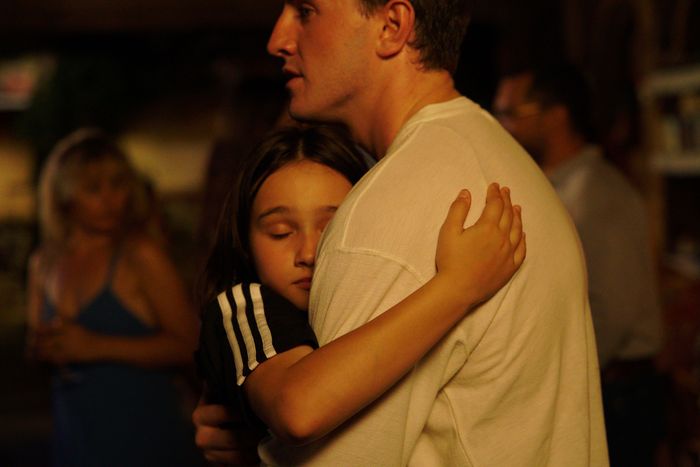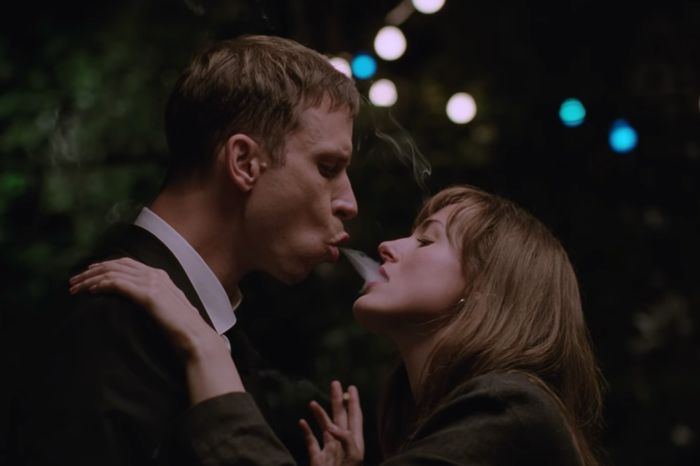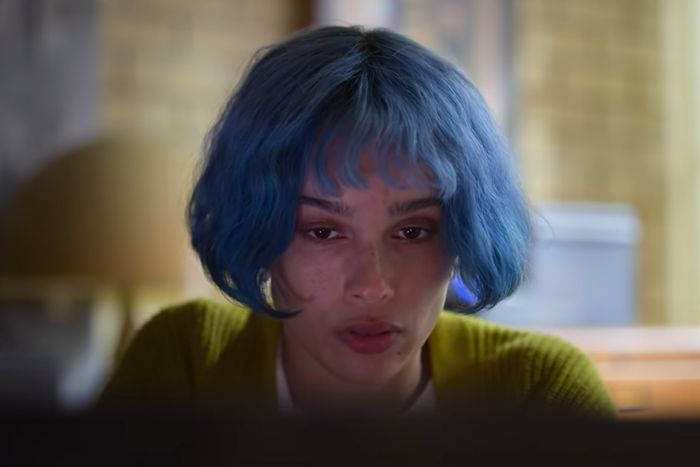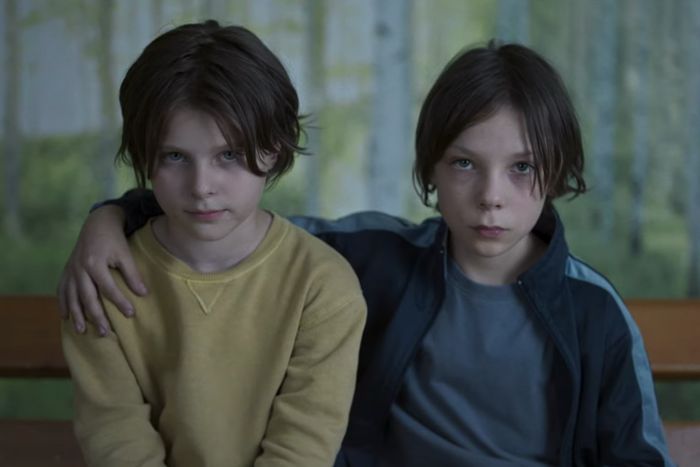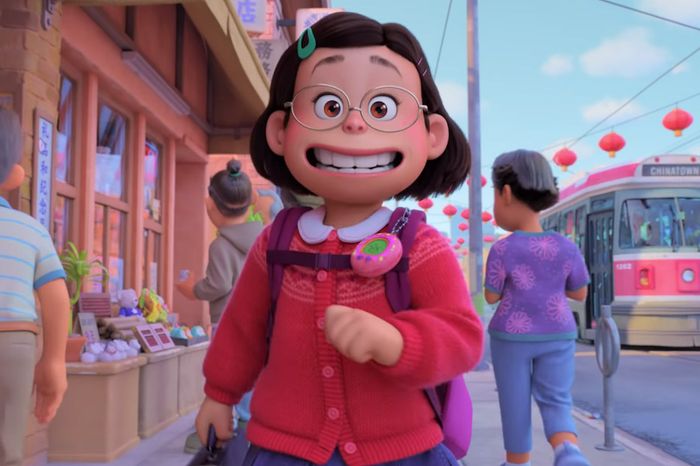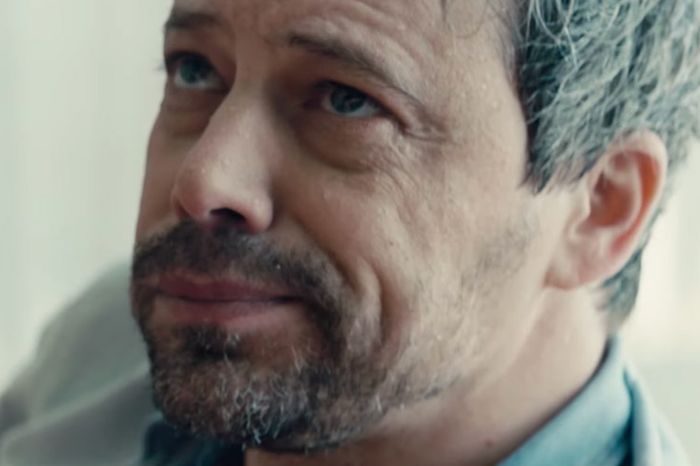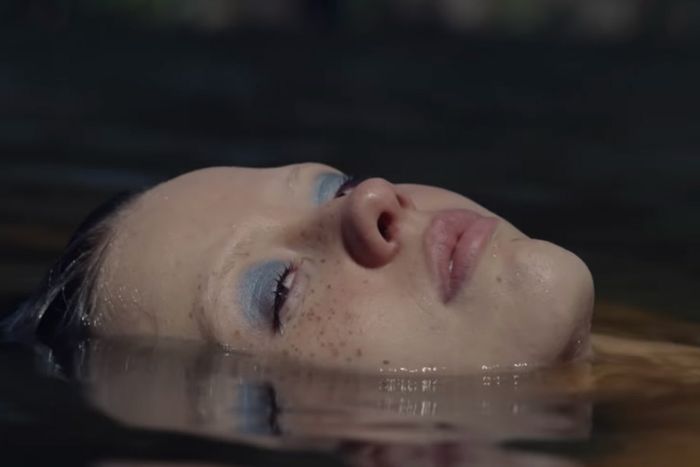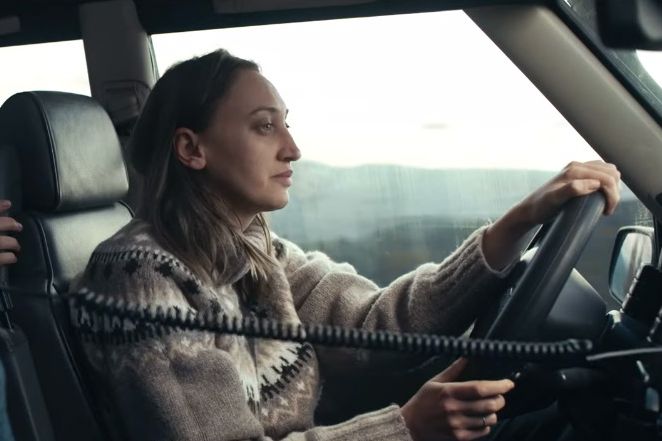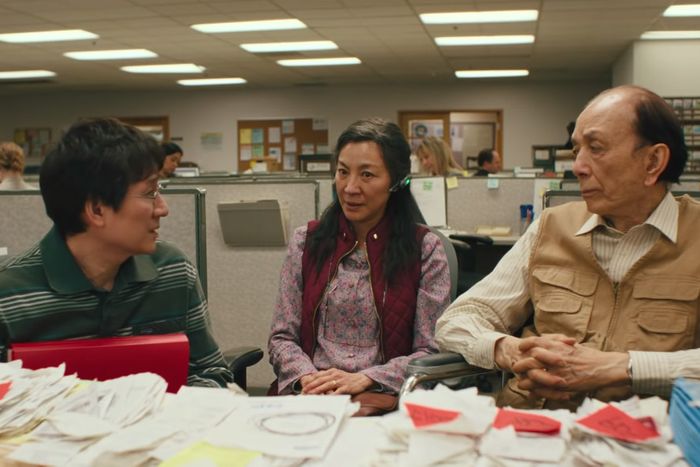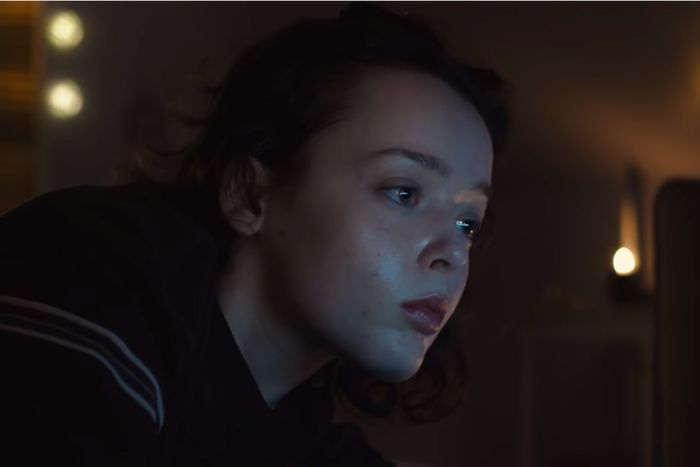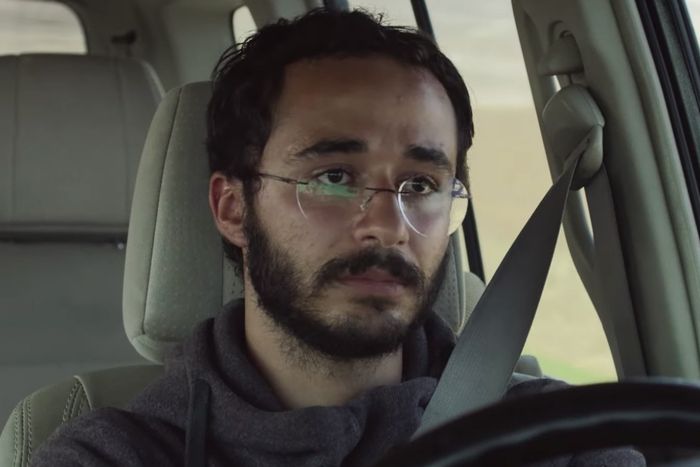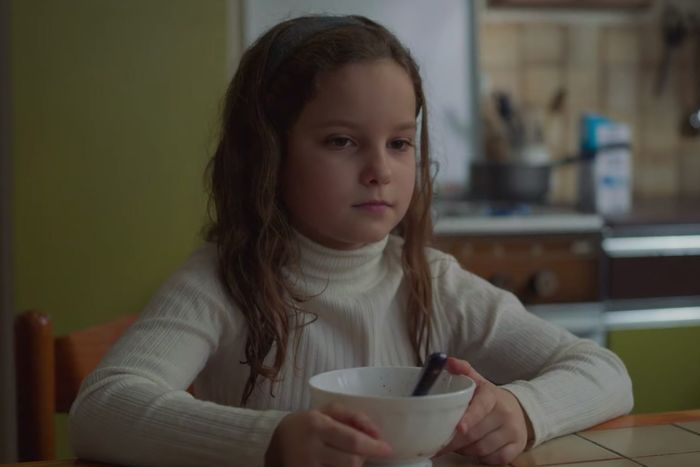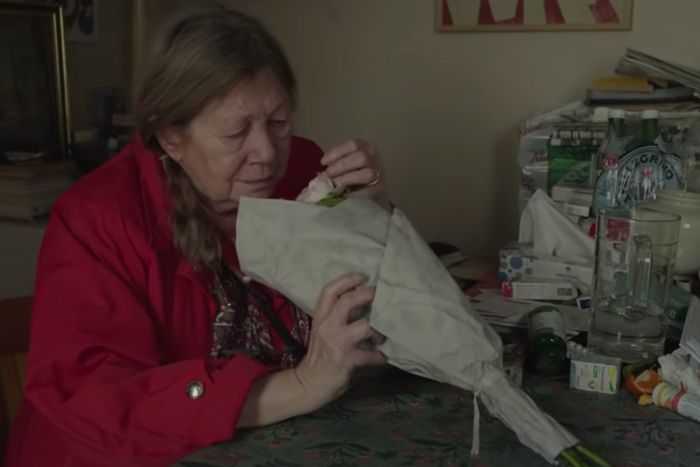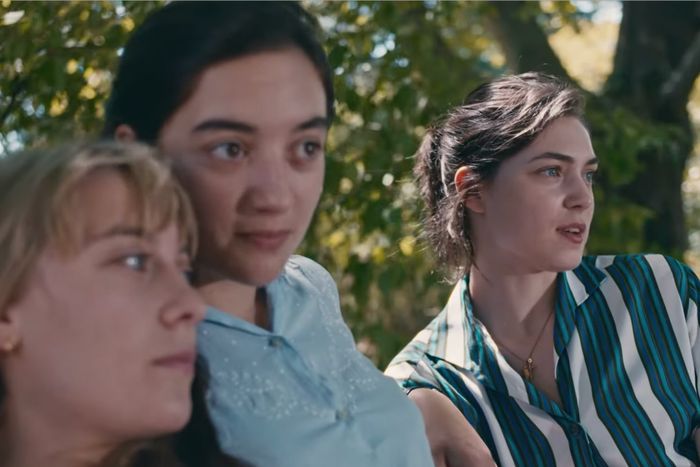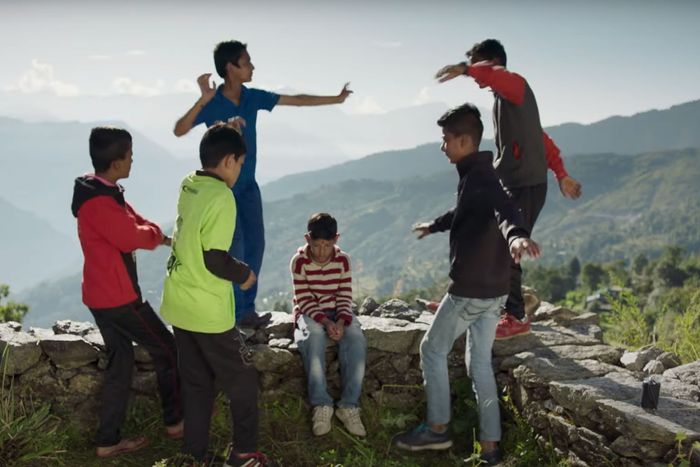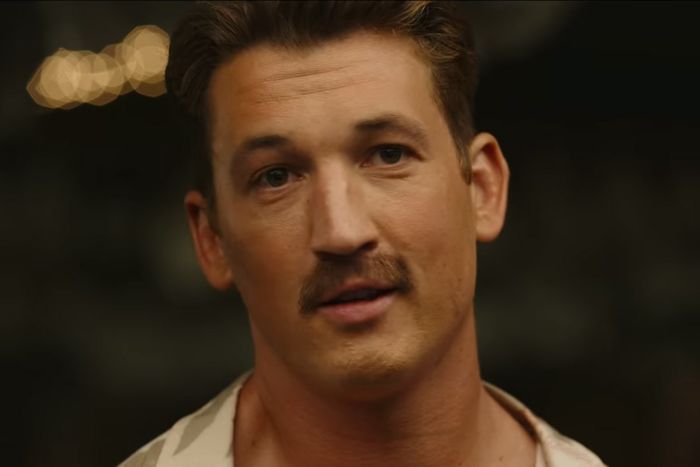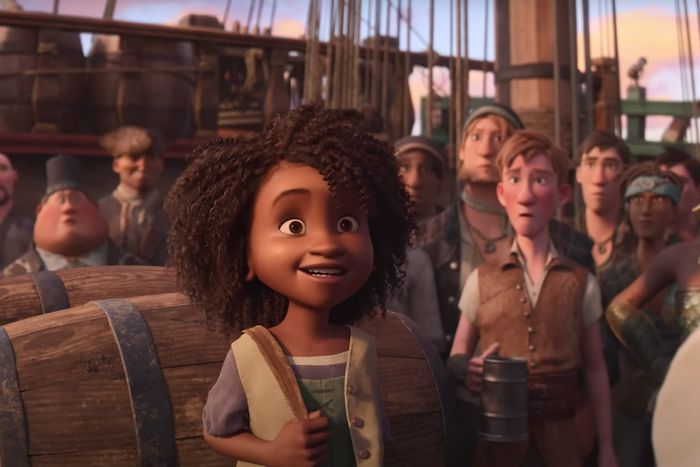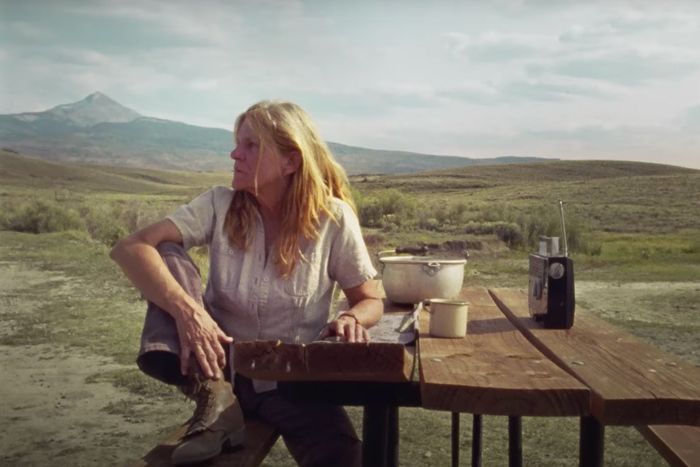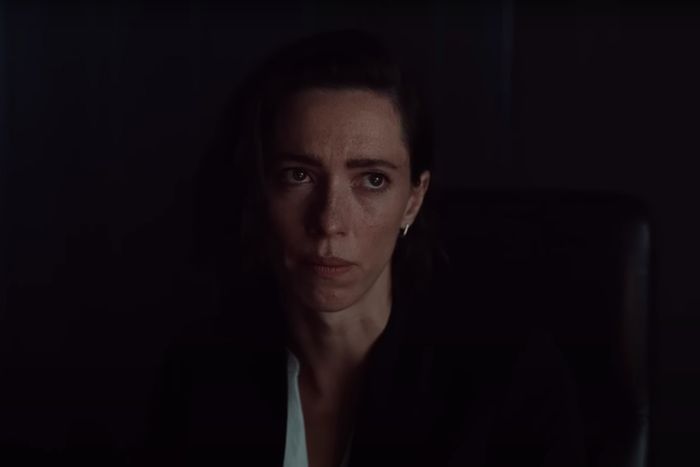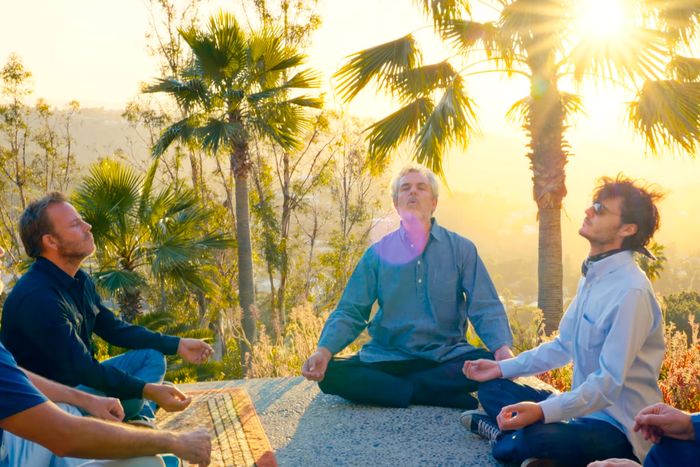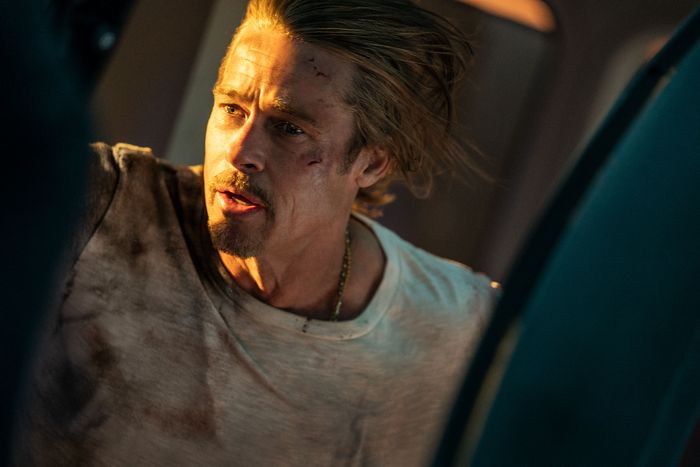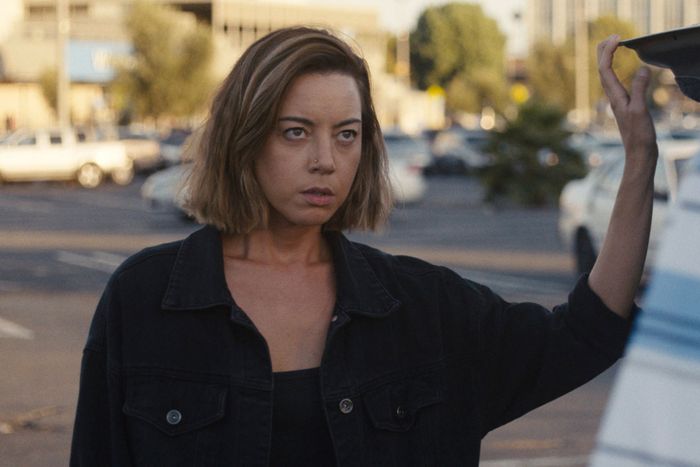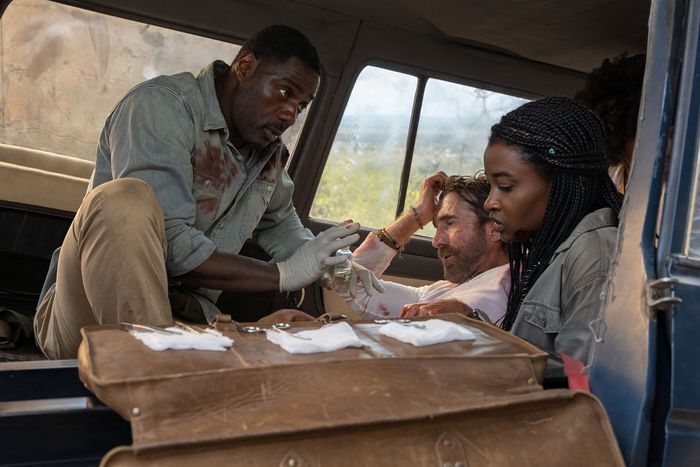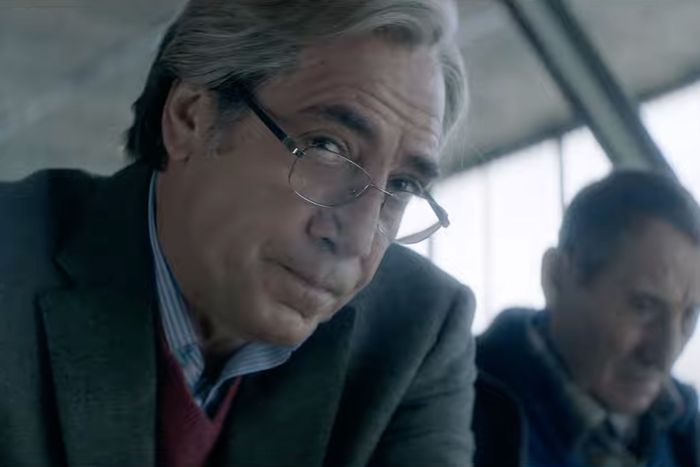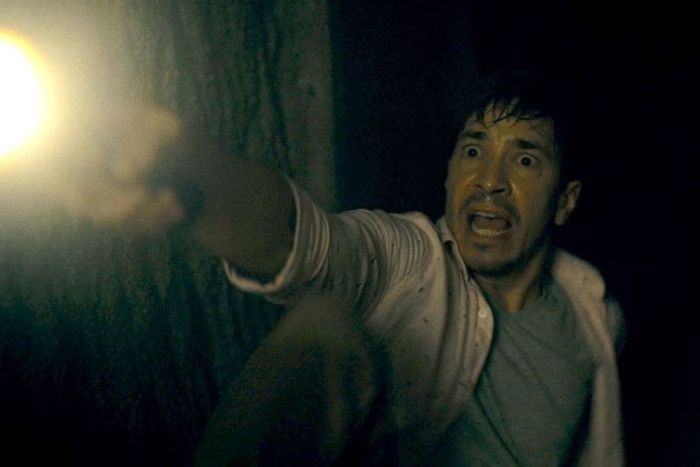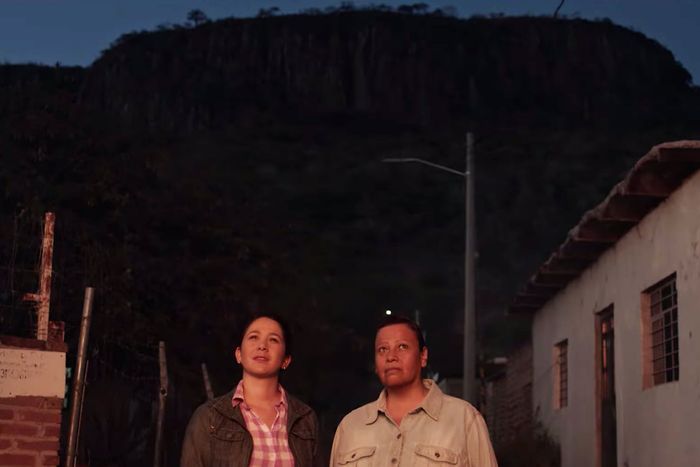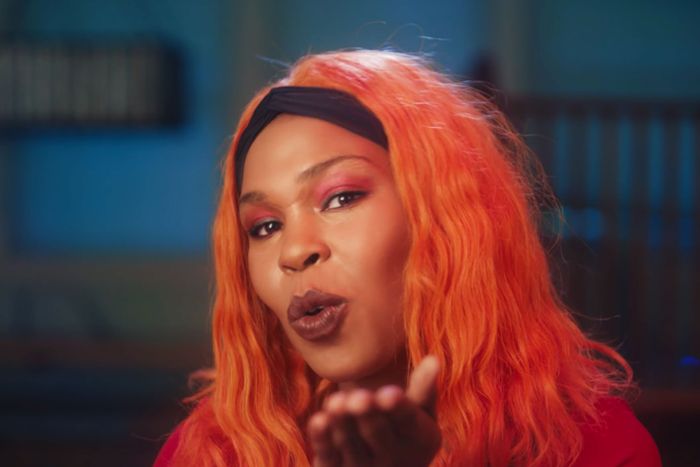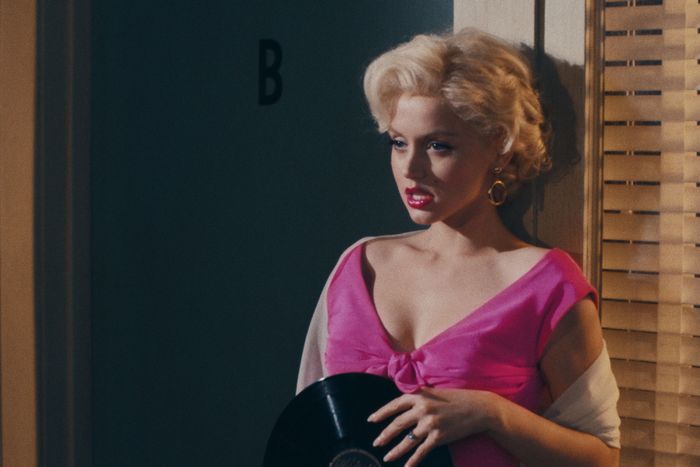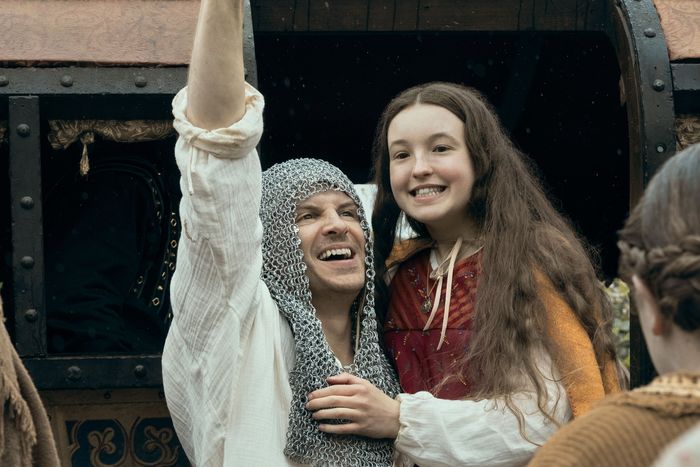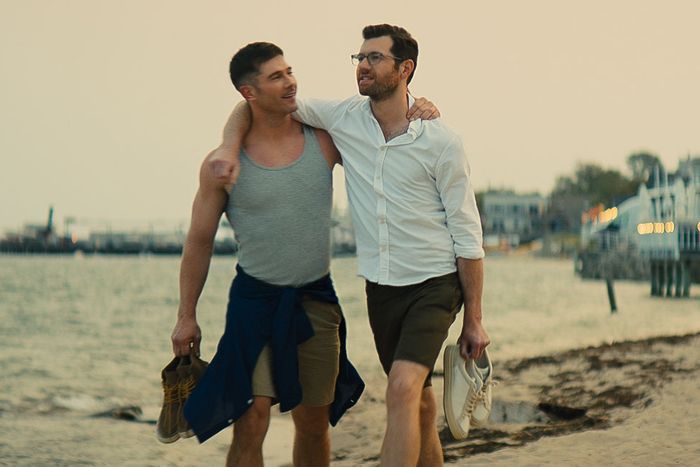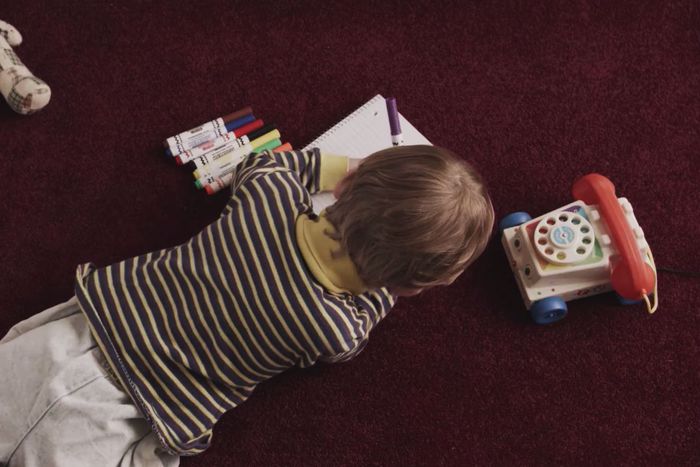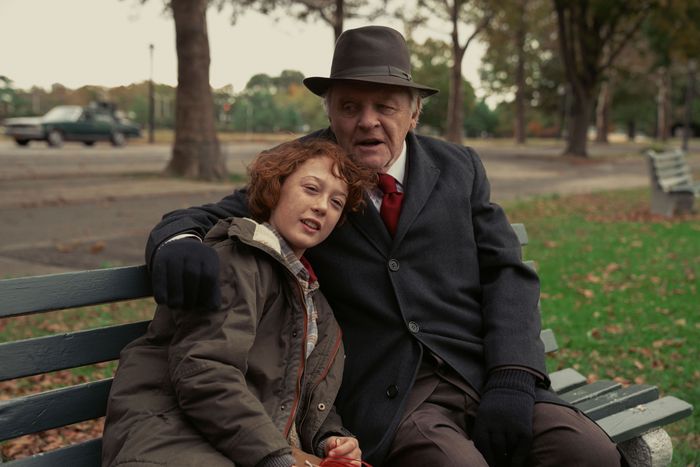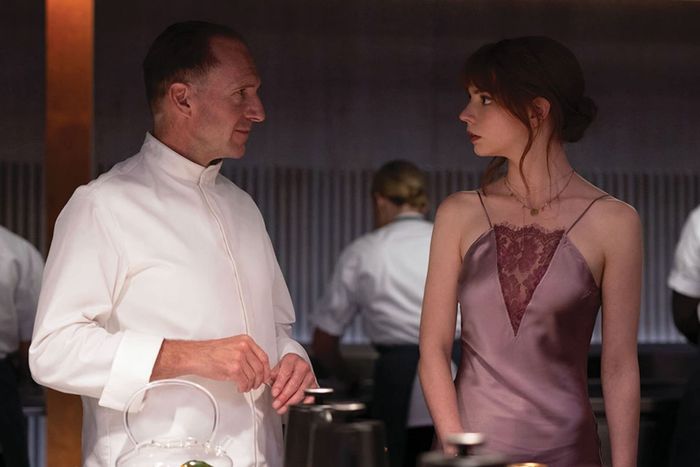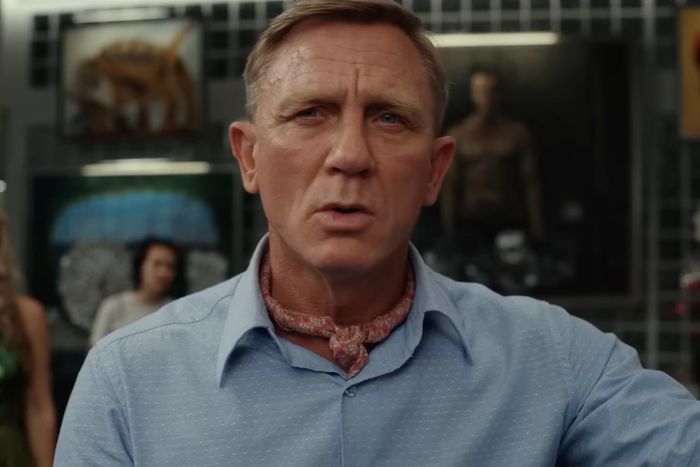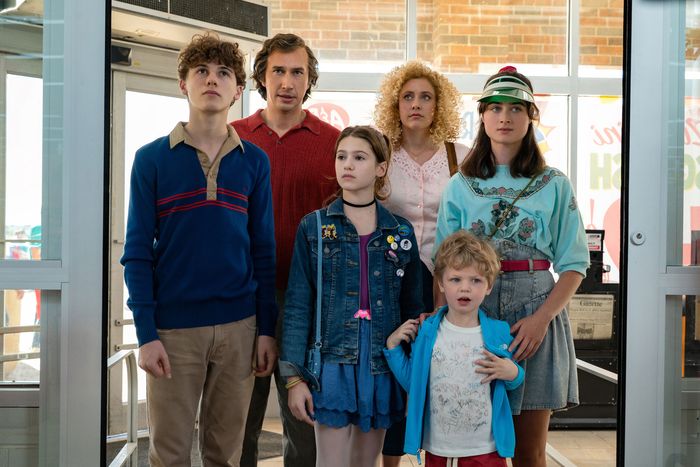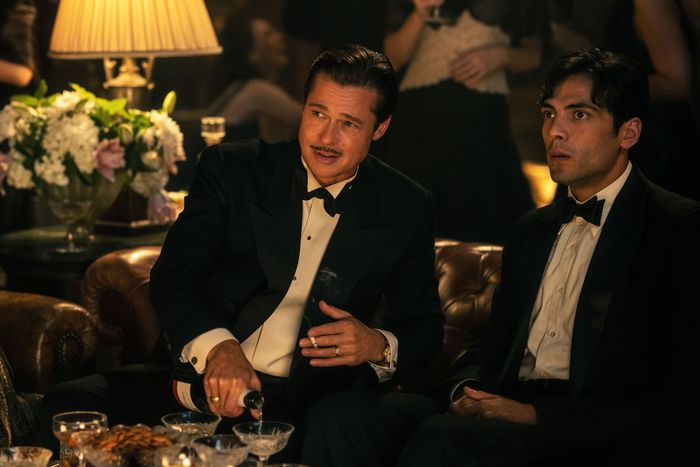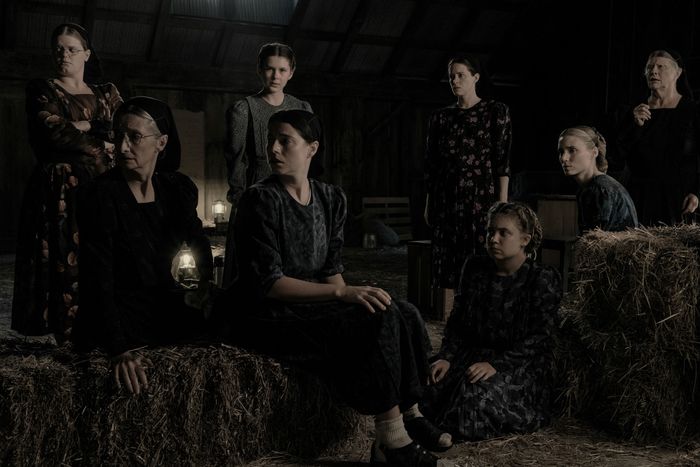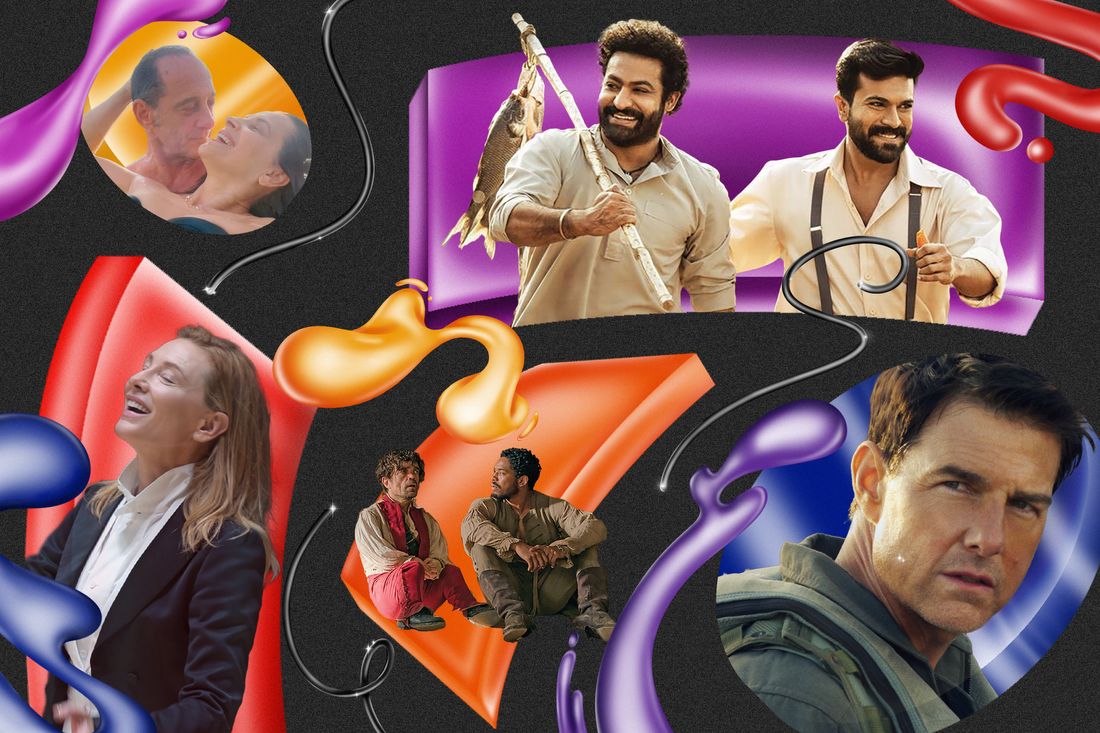
This year, the iron grip that streaming has held on our culture seemed to have loosened a bit. Netflix and several of its competitors took a financial hit in 2022; meanwhile, certain audiences expressed exhaustion with the idea of watching movies at home as the default option. Fans of Prey, Disenchanted, and Glass Onion bemoaned the full theatrical releases that could have been. Fans of Top Gun: Maverick, Everything Everywhere All At Once, and RRR happily embraced the insides of cineplexes after avoiding them since the pandemic (or, for some, even earlier). The future of theaters remains uncertain, but our critics are cautiously optimistic. Hey, maybe there’s a downside to envisioning streaming platforms as tubes from which people consume undifferentiated content, whenever, so long as it’s new. Maybe that ends up cheapening the experience of watching movies to the point where the work doesn’t seem as urgent or valuable?
Of course, no one feels entirely happy that so many studios’ go-for-broke investments in streaming are blowing up in their faces. (Especially when the main casualties of the streaming meltdown wind up being the non-guilty parties: the filmmakers.) And having to worry about the box office as if the entire art form is on the line based on the returns for Bullet Train is less than ideal. (It’s inadvertently turned critics into industry cheerleaders, which is not their job.) Nonetheless, when compiling their lists of the best movies of the year, our critics found some solace in the fact that even though 2022 wasn’t exactly a great year for movies, there were memorable, provocative, and even spectacular theatrical experiences to be had.
Alison Willmore’s Top 10 Movies
10.
Flux Gourmet
Peter Strickland calibrates the details of his absurd universe with such precision and verve that it would be pleasure enough just to get to explore it — the culinary collectives, whose experimental soundscapes–cum–performance-art freakouts make them the equivalent of rock stars, and the institute of sonic catering, with its competitive and highly structured residencies. But Flux Gourmet manages to be an incisive comedy about the relationship between celebrity and art, and between charisma and technique, and also, somewhere in all of that, about the vulnerability of an inexplicably wayward body. There was no more satisfying film about the nature of artistic collaboration and the shame of holding in farts this year.
Read Alison Willmore’s review of Flux Gourmet and Rachel Handler’s interview with writer-director Peter Strickland.
9.
Saint Omer
A novelist named Rama (Kayije Kagame) attends the trial of a woman accused of killing her 15-month-old baby, intending to turn the story into a retelling of Madea, and instead finds a dark reflection of all her own relationships and fears. Alice Diop’s film is like a knife slowly plunged into the heart, a pointed missive about immigration and alienation tucked away inside a legal drama. As Laurence Coly, Guslagie Malanga is a figure of tragic dignity in the face of condemnation and incomprehension, though it’s Rama’s silent observation of her testimony that makes the film so devastating. A fellow daughter of Senegalese immigrants who, like Laurence, feels estranged from her mother, and who’s also preparing to have a child with her white lover, Rama seems like the only person in the room who can actually see Laurence as she is — a young woman whose desperate isolation is as much a testament to the impossibly flawed bargain of assimilation as the lack of understanding she receives.
8.
The Banshees of Inisherin
The Banshees of Inisherin is a panic dream of a movie, though it’s so craftily constructed by writer-director Martin McDonagh that it takes a while for the sheer horror of its premise to sink in. As sweet, boring Pádraic Súilleabháin, Colin Farrell is the picture of uncomplicated contentment, happy to spend time with his sister Siobhán (Kerry Condon) and his miniature pony, Jenny, and to head off to the pub every day with his bestie Colm (Brendan Gleeson) — until the day that Colm abruptly informs him that they’re no longer friends. Thanks to McDonagh’s darkly funny writing and chewy dialogue, that film takes us from shock on behalf of Pádraic’s shaken universe to sympathy for how suffocating Siobhán and Colm have been finding their island existences. Pádraic’s blithe incomprehension and Colm’s apocalyptic commitment put them on a path toward doom that The Banshees of Inisherin lightly connects to the civil war going on over on the mainland, but the film is just as effective as a ruthless skewering of every emerald-tinted romanticization of rural Irish life.
Read Alison Willmore’s review of The Banshees of Inisherin.
7.
Nope
Simultaneously the least inviting and the best of the three features Jordan Peele has directed so far, Nope floats a strange, momentous parable from the outskirts of Hollywood and the end of the world. If Nope appears to resist any neat readings, maybe that’s because it should be taken at face value — as the story of three people who, when confronted with indisputable proof of extraterrestrial life, only think to use it to get ahead in show business. Goofy and spooky — cinematographer Hoyte van Hoytema’s skies are as gorgeous and oppressive as the water in Jaws — Nope also feels like an alien movie for a society in decline. Steven Yeun’s poor, broken Jupe may experience a sense of deluded wonder when he looks up at what he thinks is a spacecraft, but the pragmatic Haywood siblings (played by Daniel Kaluuya and a wonderfully kinetic Keke Palmer) understand that it’s the image of the thing and, more importantly, who owns that image that really matters.
Read Alison Willmore’s review of Nope, Katie Rife’s guide to the movie’s Easter eggs and references, and Roxana Hadadi’s behind-the-scenes story with cinematographer Hoyte van Hoytema.
6.
Both Sides of the Blade
Grégoire Colin’s character approaches from the horizon like something out of legend in Claire Denis’s bruising, brilliant romantic drama, but by the time we’re able to glimpse him up close, he doesn’t look like anything special — handsome, sure, but also a little silly with his dime-store displays of dominance. Nothing to wreck a home over, but then Both Sides of the Blade isn’t a movie about a love triangle so much as one about middle-aged adults leaping at an excuse to blow up their seemingly stable lives. Sara (Juliette Binoche) and Jean (Vincent Lindon) crumble at the sight of this figure from their shared pasts like two supporting characters finally reunited with a protagonist. Denis’s film is a marvel of exploration into how we can get older without necessarily getting wiser, culminating in a series of agonizing, emotionally dishonest, painfully believable fights that turn the couple’s airy Parisian apartment into a claustrophobic battleground.
Read Alison Willmore’s review of Both Sides of the Blade.
5.
RRR
S.S. Rajamouli’s period action epic made every mainstream Hollywood attempt at entertainment this year look like it was playing dead. An audacious act of historical fan fiction that imagined a friendship between real Indian revolutionaries (played by Telugu stars N.T. Rama Rao Jr. and Ram Charan), RRR packs in three over-the-top action set pieces before its title credits, while also cramming in sequences of romantic comedy, melodrama, a song-and-dance number, a rescue involving piggyback, and an attack on a colonial governor’s mansion that involves a dozen wild animals. There’s a legitimate critique to be made about the film’s raging nationalism, though in a year in which American audiences flocked to Top Gun: Maverick, it’s hard to feel in a place to judge. The truth is that RRR’s excesses are a reminder of the power of the medium of film to offer pure, exhilarating pleasure, something it really can feel like we’ve forgotten.
4.
All That Breathes
The birds that the brothers in Shaunak Sen’s gorgeous documentary spend their time trying to save aren’t endangered or even especially beloved. Black kites are commonly found circling above Delhi, which lends an added spiritual dimension to the work that Nadeem Shehzad and Mohammad Saud do scooping up the injured and sick and attempting to heal the raptors they find ailing around the city. As framed by Sen’s meditative lens, the siblings are engaged in a kind of futile but impassioned effort to balance out the burdens of industrialized human existence — Delhi, with its heavy pollution and increasingly cluttered skies, proves a hostile environment for birds and, as sectarian violence erupts nearby, for the film’s subjects. But as the shots of monkeys, rats, and flies making homes for themselves in or above the urban streets attests, nature has a way of adapting. It’s people who may prove more fragile in the end.
3.
Tár
Lydia Tár may not be real, but goddamn does Todd Field make you believe she could be, thanks to Tár’s exquisitely rendered world of performing-arts organizations, private planes, and near-subliminal satire. Then, of course, there’s that towering performance from Cate Blanchett, who summons every memory of charming swagger and regal imperiousness from past roles to play a character whose musical greatness is accompanied by a fatal amount of self-mythologizing. Field’s is a fascinating film about power and abuse, about a pioneering female conductor who prefers to categorize her successes alongside those of the men who’ve dominated her field, and who’s picked up some of the same toxic tendencies as well. In a year with two movies dealing directly with Me Too themes, it’s actually Tár’s sidelong take on misconduct that leaves the biggest mark, because it’s willing to be the most cynical. Field shows everyone bending to accommodate Lydia in her whims, tirades, and exploitations, and when they stop, it’s not because she’s taken advantage of younger women, but because the news that she’s done so has tarnished her carefully honed brand.
Read Alison Willmore’s review of Tár.
2.
Aftersun
There’s a scene in Charlotte Wells’s incomparably delicate directorial debut in which 11-year-old Sophie (Frankie Corio) goes up to sing karaoke as part of what’s clearly been a tradition for her and her father, Calum (Paul Mescal) — though this time, he refuses to come up with her. Alone in the spotlight, faltering her way through “Losing My Religion,” she seems to have her first major brush with self-consciousness, as though her looming teenagerdom were suddenly casting a long shadow over the moment. It’s sad as well as infuriating, a miniature instance of parental peevishness leaving a mark on a young girl, though layered on top of the recollection of this incident is the now-adult Sophie’s awareness that her father was going through a bout of depression from which he was trying his best to shield her. Aftersun is a melancholy marvel of beats like that, evoking the sense memory of a child and the more measured perspective of a woman trying to look back and perceive her dad as a fellow adult, to somehow fold the years together and meet him on the same level.
Read Alison Willmore’s review of Aftersun.
1.
No Bears
Over a decade ago, in 2010, Jafar Panahi was sentenced to six years in prison and a 20-year ban on directing films. He has, in the time since, directed five features; the unfathomable difficulty of this feat is as astonishing as how vital and how good his work continues to be. No Bears may be the best of them all — a slippery, achingly ambivalent film questioning the value of the art he continues to pursue despite facing incredible obstacles. Panahi plays himself, having found lodging in a remote village, wanting to be near his latest production, which is shooting just across the border in Turkey, even if he’s not allowed to travel there personally. As he guides his actors remotely through a docudrama based on their own immigration struggles, Panahi becomes embroiled in a local drama involving a young woman trying to get away from the man she was engaged to at birth in order to elope with the one she loves. The act of capturing images of people, of recording their lives or something like it on camera, becomes a fraught exercise in both of these stories, not neutral but a potentially damning position of privilege. Filmmaking has, perversely, never been made to feel more powerful this year — No Bears is thrilling, queasy cinema.
Bilge Ebiri’s Top 10 Movies
10.
Descendant
One often sees documentaries that seem to have benefited from simply finding a fascinating story and getting out of the way in telling it. Here’s one that actually makes bold choices, exploring its subject in a way that emphasizes its human dimension. Right before the Civil War, the Clotilda, the last ship to bring enslaved Africans to the United States, dropped off its human cargo in Alabama and was promptly scuttled by its captain in Mobile Bay. In the years after the war, the descendants of those Africans stayed in the area, many of them living in a community called Africatown, which exists to this day. Margaret Brown’s film charts the tale of the Clotilda and the search for its wreckage, but it does so while centering the lives and experiences of the current inhabitants of Africatown, for whom this story is not some fascinating historical anecdote but part of a complicated, sad legacy that continues to haunt them.
9.
Murina
In Croatian director Antoneta Alamat Kusijanović’s debut feature, a teenage girl (Gracija Filipović) living on the Dalmatian coast rebels against her domineering, emotionally abusive father (Leon Lučev) by trying to rekindle the affection that once existed between her mother (Danica Curcic) and an old family friend (Cliff Curtis). The logline might sound potboilery, but director Kusijanović’s eye for detail and present-tense sensibility creates something wonderfully immersive and alive. The dry, craggy shore and the gray-blue sea seem to speak to the protagonist’s hopelessness and desolation, while the emotional warfare between father and child manifests itself through the physical reality of the world around them. We see a lot of coming-of-age movies and tales of family conflict; rarely are they this anxiety inducing.
Read Bilge Ebiri’s review of Murina.
8.
Lingui, the Sacred Bonds
We often talk about how the theatrical experience is essential when you’re seeing big movies — your Avatars, your Babylons, your Tops Gun. But the truth is that the big screen is just as critical, if not more so, with smaller films. Witness this latest effort from the veteran Chadian filmmaker Mahamat-Saleh Haroun (A Screaming Man, Abouna). On its surface, it’s a spare, intimate drama about a single mother (Achouackh Abakar Souleymane) and her 15-year-old daughter (Rihane Khalil Alio) on the dusty outskirts of N’Djamena whose lives are upended when the girl becomes pregnant. As the devout mother helps her daughter seek an abortion, a tense, tender story emerges. But Haroun’s use of sound and image creates a whole extra layer of realism that becomes mesmerizing and momentous on the big screen. Wide shots emphasize these characters’ relationships to the society around them, which is, of course, what the film is all about; as it proceeds, we see how the minute connections between these women and others begin to factor into their ordeal. Haroun also sucks us in with his immersive sound work, placing us squarely in this world so that we absorb its rhythms, its attitudes, its textures. We are there. Lingui is a transporting movie, but not an escapist one. It plunges us into its world so vividly that the characters’ anxieties become our own.
7.
Compartment No. 6
In director Juho Kuosmanen’s moody miniature, a Finnish grad student in Russia (Seidi Haarla) finds herself stuck in a drab train compartment traveling from Moscow to Murmansk with a boorish young Russian man (Yuriy Borisov). It’s the late 1990s, towards the end of the Yeltsin era, and the industrial, post-Soviet landscape that races outside the train is cold, forbidding, indifferent. It’s not particularly welcoming inside the train, either. These two people couldn’t be more different. She seems utterly incapable of navigating this reality, while he seems utterly incapable of navigating anything but this reality. Of course, it’s no narrative surprise that they will come to understand each other over the course of this film, but director Kuosmanen portrays their changing relationship with such emotional specificity, such captivating atmosphere, that by the time it’s all over Compartment No. 6 feels not so much like a movie you saw but a real-life encounter that you yourself had.
Read Bilge Ebiri’s review of Compartment No. 6.
6.
Three Thousand Years of Longing
Adapting an A.S. Byatt novella, George Miller attempts to conjure a modern-day One Thousand and One Nights story, and he absolutely nails it. No other film has so effectively evoked the memory of the tales I grew up with, even though this is far from your typical, old-fashioned, magical-mystical fable, re-creating the wonder of those stories even as it deconstructs the very nature of storytelling. As a djinn whose forbidden desire led to his confinement in a bottle for millennia, Idris Elba gives a performance that veers from desperation to melancholy to reflection, while Tilda Swinton’s standoffish academic fights off the yearning that his tales evoke in her. The whole movie is ultimately about confinement — physical, psychological, and emotional — and the need to open ourselves up to the madness, wonder, and heartbreak of this world.
Read Bilge Ebiri’s review of Three Thousand Years of Longing and his interview with director George Miller.
5.
No Bears
Before he was placed under house arrest in 2011 (after many months of imprisonment and other legal difficulties), Jafar Panahi was one of the foremost chroniclers of contemporary Iranian society, of the way that resourceful, independent-minded people made their way around surreal levels of oppression. Once confined indoors and limited in movement (and technically forbidden from making movies), Panahi effectively turned the cameras on himself in a series of innovative films that explored the role of the artist in a world that was paradoxically both unhinged and highly circumscribed. Earlier this year, Panahi was imprisoned, along with many other activists and artists, and No Bears seems like it may well be his final film in this particular career chapter; we do not know what will be next for him, or if he’ll ever be able to make another picture again. No Bears also happens to be the director’s best film in nearly 15 years, chronicling his efforts to remotely shoot a feature in Turkey while perched in a small town near the border. Freedom glimmers beyond the hills; all the director needs to do is to hitch a ride one night on one of the many “go-fast cars” used by smugglers in the region. But what does it mean to leave home for a filmmaker for whom the immediate world outside his windows has always been an inspiration? No Bears is certainly about Panahi’s own predicament at this particular moment in time, but it’s also about the artistic impulse in general.
4.
Cyrano
Full disclosure: Cyrano made my Top 20 list last year, back when it was supposed to come out in 2021 and before the studio scuttled its release at the last minute. In the ensuing months, I’ve rewatched the film over and over again, and it’s risen even further in my estimation. Joe Wright has always been, secretly, a musical director, and now, he’s finally made a musical, taking one of theater’s great romantic triangles and turning it into an infectiously cinematic extravaganza. At its center, of course, is an unforgettable performance by Peter Dinklage, who forsakes the traditional giant schnozz and allows his face to express the full range of emotion required of this part.
Read Bilge Ebiri’s review of Cyrano.
3.
Both Sides of the Blade
2022 should have been the year of Claire Denis. In the span of one year, she released two ambitious features, both of which won big awards at major festivals, and her 1999 masterpiece Beau Travail ranked very high in the Sight and Sound Greatest Films of All Time poll. (She was one of only three living directors to crack the top ten — and the only one who has a new movie out this year.) Stars at Noon, her Cannes Grand Jury Prize winner, was a frustrating effort in some regards, but no less fascinating for being so. For my money, however, Both Sides of the Blade (which won Best Director at Berlin), starring Juliette Binoche as a happily remarried woman whose love for her ex is rekindled when he reappears in her husband’s life, is one of her greatest films, blending Denis’s characteristic impressionism with a fevered romanticism that feels achingly personal and new.
2.
Top Gun: Maverick
Some will tell you that what makes Maverick so special is the fact that it replicates the style and feel of one of those fun summer blockbusters from the 1990s. Here’s the thing: These people are well meaning, but they’re wrong. Maverick is far more than just a solid, old-fashioned action flick. It’s an exceptionally well-made drama about time, and about how much Tom Cruise’s protagonist — and by extension Cruise himself, and America — has changed over the ensuing decades. One of these days it will dawn on all of us what a miracle this movie is.
1.
Athena
Romain Gavras’s electrifying film about an uprising at a French housing project in the wake of a police killing has a subject ripped from the headlines, a structure borrowed from Greek tragedy, and an aesthetic that is pure gonzo, go-for-broke, epic moviemaking. But while the picture is filled with bravura, how-the-hell-did-they-do-that sequences — including an 11-minute single-shot opening that is one of the most breathtaking things you’ll ever see, anywhere — what makes Athena so, so powerful is the extremely human tale of shattered brotherhood that lies at its heart.
Read Bilge Ebiri’s review of Athena.
Other Movie Highlights From This Year
Throughout 2022, our critics maintained “Best Movies of the Year (So Far)” lists. Many of those selections appear above in our Top 10 picks. Below are more of the films (but not all) that stood out to them this year.
January
Belle
A metaverse fairy tale and a wistful story of self-affirmation, the latest film from Mamoru Hosoda keeps one foot in a digital world that serves as an escape for billions of people around the world. One of them is Belle’s heroine, an unremarkable teenager from a fading rural community who, in her anonymous online life, has become a famous pop star. While Hosoda’s film uses Beauty and the Beast as its main inspiration, what makes it so compelling are the ways in which it plays the real and virtual off one other, diverging from the familiar contours of the classic story to show how even when we remake the world as a teeming new space where everything is possible, we bring all our pain and baggage with us. — Alison Willmore
Read Alison Willmore’s review of Belle and Rafael Motamayor’s interview with director Mamoru Hosoda.
February
Jackass Forever
Jackass Forever is a kinder, gentler Jackass, but thankfully, it’s not a more mature one. If anything, Johnny Knoxville and his merry band of gluttons for punishment have regressed, in the best way possible, utilizing the full array of modern filmmaking to portray some of the most sophomoric stuff ever put onscreen. Even so, what makes a Jackass stunt a Jackass stunt isn’t really the difficulty or the cleverness or the grossness of the activity, but the interactions among the perpetrators, victims, and spectators. First comes the stunt, then comes the agony and, finally, the camaraderie. There is a lot of hugging in Jackass Forever, believe it or not, and most of it feels sincere. While enormously fun, this is a more emotional movie than previous entries. You sense that among the people onscreen, and you might also sense it in the audience. Watching these middle-aged masochists keep hurting themselves for our pleasure reminds us of the passage of time. — B.E.
Read Bilge Ebiri’s review of Jackass Forever.
The Worst Person in the World
The coming-of-age genre is usually saved for teenagers and people in their very early 20s, despite the fact that the nature of being human is to be in a constant state of flux. It’s why I find coming-of-age films focused on the turbulent decades of true adulthood so ripe — when the buildup of breakups, breakthroughs, accomplishments, and beliefs is starting to loom large. The Worst Person in the World, Joachim Trier’s final film in his loosely constituted Oslo Trilogy, sidesteps the arch emotional beats that define stories of very young people in love. It charts the growth of Julie (Renate Reinsve) from her 20s into her 30s and the relationships she has with two primary men in her orbit — first, Aksel (Anders Danielsen Lie), an older artist, and second, Eivind (Herbert Nordrum), a barista who catches her eye at a party she crashes. These characters aren’t neatly good people with perfect politics who say what they mean and mean what they say. They fuck up, in sometimes glorious ways, and are accountable for those fuckups. Trier’s approach to their stories is piercingly aware of the bruises we accumulate trying to become something more than our present selves. The story quietly washes over you until you realize you’re drowning in waves of acute emotions. — Angelica Jade Bastién
Read Angelica Jade Bastién’s review of The Worst Person in the World.
Air Doll
Left without a U.S. distributor for years, this melancholy 2009 Hirokazu Kore-eda film is the myth of Galatea by way of a sex shop, with a sublime Bae Doona playing an inflatable doll who comes to life when her owner is away and eventually drifts into a part-time job and a relationship with a co-worker. Like the alien in Under the Skin, the protagonist of Air Doll is an otherworldly outsider who first observes humanity, then makes an ill-fated attempt to become part of it, getting exposed to humanity’s capacity for cruelty in the process. — A.W.
Kimi
Steven Soderbergh’s latest is a fleet-footed, gorgeously made suspense movie about an agoraphobic tech contractor who hears what she believes to be a rape when analyzing audio from an Alexa competitor. As the isolated Angela Childs, Zoë Kravitz is both prickly and vulnerable, upset that she’s not able to push past her own trauma and just return to normal alongside the rest of the world — until she believes she has no choice but to force herself outside and into a conspiracy that’s both horrifying and tawdry. — A.W.
Read Alison Willmore’s review of Kimi.
Playground
Playground begins and ends with an embrace, but between those two instances of tenderness lies a nerve-shredding, incredibly well-acted 72-minute drama set in the guilelessly cruel world of young children. There have been lots of movies about bullying, but I’m not sure I’ve ever seen one like Laura Wandel’s, which is shot, cut, and performed with an immediacy that puts us inside the queasy, terrified mind of a 7-year-old girl. The film’s child’s-eye perspective is so relentless we almost never see a parent or teacher’s face unless they’re leaning down or sitting at our protagonist’s level — a striking visual correlative to the general helplessness of the adults around these kids. Playground is a tough watch, but it’s also an essential one. — B.E.
Read Bilge Ebiri’s review of Playground.
The Burning Sea
Any true fan of disaster flicks would do well to check out this Norwegian release, which is being billed as a sequel of sorts to modern-day classics The Wave (2015) and The Quake (2018) from the same country. It does share a director with the latter — John Andreas Andersen — but it’s a far more sober and intimate film than either of its predecessors, relying more on tension than spectacular, over-the-top devastation. This time, a Norwegian offshore-drilling company is sent into a tailspin when it discovers that a horrific accident on one of their rigs might actually be the start of a once-in-a-millennium seismic event that will cause a massive oil leak. Their solution: to light the North Sea on fire in order to burn up all the oil before it can spread out and destroy the European coastline for generations. Unfortunately, one of our heroes is trapped on one of the rigs in the middle of this flaming cataclysm. The results are intensely dramatic — more survival flick than disaster porn. — B.E.
The Long Walk
A beguiling mix of science fiction, ghost story, and spiritual meditation, Mattie Do’s third feature is set in a rural Laotian village to which the future has brought a scattering of technological advances but few solutions for the economic stagnation driving new generations to the city for work. Yannawoutthi Chanthalungsy is the unnamed protagonist, a man who’s always been able to see the dead but who only learns as an old man that the ghost who’s been his companion since he was young has the ability to take him back in time. The Long Walk is about someone trying to fix the past, with all kinds of unforeseen consequences. But it’s also a moody portrait of someone so sure he knows how to help those in need that he can’t actually see the monstrosity of his actions. — A.W.
March
After Yang
Kogodana’s latest is an exquisitely melancholy movie about the life and death of a robot, but it’s also about finding significance in the moments and textures of a mundane existence. Jake (Colin Farrell) and Kyra (Jodie Turner-Smith) purchased Yang (Justin H. Min) to help their adopted daughter Mika (Malea Emma Tjandrawidjaja) connect to her Chinese heritage, but never fully appreciated the place he occupied in their family until he stops working. In trying to get the secondhand companion android repaired, Jake discovers Yang had a whole inner life and history that leads him to reconnect with his own existence. After Yang’s meditative power owes so much to vividness of the near-future the film conjures up, a sun-dappled world that still feels tender from offscreen schisms distant enough to be memories but near enough to still be felt. — A.W.
Read Alison Willmore’s review of After Yang.
The Batman
You might have thought Batman couldn’t get any darker, but you’d be wrong: Heath Ledger’s Joker in The Dark Knight sewed a telephone into a guy’s abdomen in 2008 so that Paul Dano’s Riddler could then feed another guy’s abdomen to a cage full of rats in 2022. This is a Batman movie reimagined as a grisly serial-killer film, only this time it’s not just the serial killer who looms in the shadows, watching his prey and waiting to pounce; the hero does, too. The typical superhero movie’s subtext about the subtle similarities between the good guy and the bad guy here becomes overt text, as director Matt Reeves shoots Batman’s pursuit of his targets with the same psychotic, heavy-breathing, point-of-view aesthetic with which he shoots the Riddler’s. Now, we have to try and figure out how the hero differs from the villain — so too does Batman. That’s part of the film’s charm: watching a familiar, oft-filmed superhero try and discover just what it is that constitutes heroism — a question that finds its answer during a moving climax that has almost nothing to do with tracking down bad guys or pummeling people. As a result, The Batman’s darkness never feels fashionable, or opportunistic, or cheap. Reeves loves these dead-end apocalyptic environments and delights in tales that toy with the moral calculus of typical hero narratives. He has given us a Batman that he himself can believe in, not to mention a Batman that feels right for our times. — B.E.
Read Bilge Ebiri’s review of The Batman.
Great Freedom
Sebastian Meise’s searing prison drama follows the life of Hans Hoffmann (Franz Rogowski, in a haunting performance), a gay man and prison camp survivor for whom Germany’s liberation after WWII didn’t seem to make all that much of a difference. The postwar German government still kept laws criminalizing homosexuality on the books, thus resulting in him being sent straight back to prison. By juggling time periods and keeping the action largely confined to life behind bars, Meise has crafted an unusually (and beautifully) suffocating film. As we shuffle through scenes from Hans’s incarceration in the 1940s, the 1950s, and the 1960s, we feel like we’re very much stuck there with him. But the film is not without humanism: Much of it charts the growing friendship between Hans and Viktor (Georg Friedrich), an addict whose initial disgust at his fellow inmate eventually transforms into solidarity, respect, and a kind of love. — B.E.
Huda’s Salon
Palestinian director Hany Abu-Assad’s extremely gripping drama begins with a matter-of-fact depiction of a conspiracy so strange and shocking it takes a second to regain your bearings after witnessing it. Reem (Maisa Abd Elhadi), a female customer in a hair salon run by Huda (Manal Awad), is casually drugged, stripped naked, and photographed in a compromising position. Then, Huda uses the pictures to force Reem into spying for the Israeli secret service, part of an ongoing operation that has pulled many terrified women into its web. Huda’s blackmail scheme works for one simple reason: These women live in a world where just the hint of adultery — even if unproven, or for that matter disproven — is a life-shattering one. The ensuing film intercuts between two narrative strands: Huda, caught by the Palestinian resistance, is interrogated in a dark basement, while Reem desperately searches for a way to clear her name. Abu-Assad has made his share of films about the cruel absurdity of life under Israeli occupation, but here he lets all sides have it. These women are oppressed by everybody. Even though the story unfolds in linear time, as we watch these two female protagonists’ journeys, we begin to realize Reem is going through a version of what Huda herself did once upon a time. The intimate, slow-burning frustration of these two women’s predicaments builds and builds until we ourselves start to feel like we’re stuck in a dark prison of the soul. — B.E.
Read Bilge Ebiri’s review of Huda’s Salon.
Turning Red
As exuberant and unapologetically weird as its 13-year-old heroine, Domee Shi’s Pixar feature debut effortlessly combines generational trauma and adolescent hormonal awakenings, ancestral inheritances and boy band fandom, and all in a pastel-hued Toronto that, for once, gets to play itself. What makes Turning Red so joyous and also heartrending is the way it takes Chinese immigrant archetypes — the tiger mom, the good daughter — and explores the individuals behind them, finding a lonely woman repeating her own mother’s mistakes despite herself, and a young woman so determined to please the parent she adores that she’s ready to start punishing herself for not being perfect. Also, the panda is adorable, and the big panda showdown is a splendid mix of the absurd and the emotional. — A.W.
Read Alison Willmore’s review of Turning Red.
Ahed’s Knee
Israeli director Nadav Lapid’s latest abrasive moral drama follows a hotshot, award-winning director, Y (Avshalom Pollak), as he flies to the remote, dusty Arava Valley to screen one of his films to a small-town audience. He is met by Yahalom (Nur Fibak), a young, cheerful bureaucrat who works at the Ministry of Culture and asks him to sign a form declaring the subject of the film he’s screening. The document is a mere formality, but it sets Y — who is clearly a surrogate for Lapid himself — off. Not just because of the moral dilemma he faces in signing it, but also because of the paradox he senses in Yahalom, a smart, kind young woman who understands the inherent corruption behind this type of low-key censorship but nevertheless performs her job with pleasant professionalism. Interesting setup, but what makes Ahed’s Knee so powerful is the way the movie detonates before our eyes. The rage and doubt gnawing away at Y’s conscience spill over into an extended flashback, numerous dance sequences, and, ultimately, a blistering monologue – a trancelike, spittle-flecked, apocalyptic screed that practically takes the movie hostage. But Lapid reserves perhaps the greatest condemnation for himself, for Y is also revealed to be a manipulative, duplicitous, even hypocritical mess. So the film asks: At what point does constant aggrievement become its own toxic form of aggression? At what point does rage become cruelty? And at what point does merely going about one’s business perpetuate great evil? Humanity has never had easy answers to such questions, and neither does this movie. — B.E.
Read Bilge Ebiri’s review of Ahed’s Knee.
X
Sex and violence are two of the movies’ most reliable spectacles, and Ti West’s latest — his first in six years — offers up plenty of both by sending an amateur film crew out to a rural Texas farm to shoot a porn film, without telling the enigmatic elderly couple they’re renting from what their plans are. But X has more on its mind than just basking in the tropes of the classic slasher. It also interrogates the conservatism at the genre’s core by having its carnage be fueled by envy rather than by a sense of moral punishment, with Mia Goth doing double duty as aspiring sex symbol Maxine and as the despondent older woman Pearl. — A.W.
Read Alison Willmore’s review of X.
Intregalde
The most riveting film you’ll ever see about three Romanian social workers stuck in the mud. In Radu Muntean’s absorbing and bizarre drama, a mission to deliver food supplies to a remote region of Transylvania is derailed when the aid workers decide to pick up an elderly villager, who promptly sends them down the wrong path, resulting in their SUV being bogged down along the way. Assorted attempts to get the car out of the mud simply make matters worse, and the situation escalates both emotionally and physically. It all feels like a metaphor for something — institutional failure, perhaps, or the cocoon of bourgeois privilege, or the futility of temporary gestures. But that doesn’t really do justice to the film’s psychological acuity, to its lived-in sense of drama and its sharply-drawn characters. Muntean is a master of putting ordinary people in circumstances that gradually force them to reveal who they are, without it ever feeling forced, heavy-handed, or opportunistic. — B.E.
Everything Everywhere All At Once
Shave ten to 15 percent off of Dan Kwan and Daniel Scheinert’s second film and you’d have a stone cold masterpiece. As is, Everything Everywhere All At Once is still pretty damn wonderful, an epic battle across multiple universes as well as a startlingly sad portrait of an immigrant family on the verge of collapse. Michelle Yeoh is splendid as Evelyn Wang, a beleaguered laundromat owner whose marriage is failing, whose daughter Joy (Stephanie Hsu) is drifting away, and who is in the midst of getting audited by a joyless administrative ghoul played by Jamie Lee Curtis. But the real standout is former child actor Ke Huy Quan, of Indiana Jones and the Temple of Doom and The Goonies. As Evelyn’s whimsical husband Waymond, he’s the heart of the film, and he’s the star of a fanny pack martial arts battle that’s guaranteed to be one of the year’s best action setpieces. — A.W.
Read Alison Willmore’s review of Everything Everywhere All at Once and Bilge Ebiri’s interview with star Ke Huy Quan.
Nitram
In between Shakespeare and video game adaptations, Justin Kurzel has been a reliable chronicler of Australia’s history of violence, beginning with Snowtown in 2011 and continuing with True History of the Kelly Gang in 2019. But Nitram, a portrait of the perpetrator of the 1996 Port Arthur shooting, feels like the culmination of Kurzel’s interests in the mundanity of evil. A mesmerizing Caleb Landry Jones plays the title character, a lonely, disturbed man with a penchant for perverse acts of provocation. Nitram immerses the viewer in his experiences, which veer between the pathetic and the repellent, a tightrope walk of empathy without sympathy. — A.W.
Read Roxana Hadadi’s review of Nitram.
April
Babi Yar. Context
The Ukrainian director Sergei Loznitsa made headlines a few weeks ago when he was expelled from the Ukrainian Film Academy for opposing a boycott of all Russian films and directors — this, after he himself had resigned from the European Film Academy for its weak response to Russia’s invasion of his country. But Loznitsa himself suspects that the real reason for his expulsion was because some were upset over this devastating documentary about the Nazi invasion of Ukraine and the notorious massacre of Kyiv’s Jews that occurred at the Babi Yar ravine on the city’s outskirts. Using footage entirely shot by cameramen of the time, Loznitsa tells the story of the city’s capture and the monstrous events that followed, but he also shows how complicit many ordinary citizens were in helping perpetrate the Nazis’ crimes. Ultimately, what Babi Yar. Context shows is how the uncontrollable poison of war always spreads far beyond the battlefield and those fighting on the front lines. — B.E.
We’re All Going to the World’s Fair
Somewhere between a horror film and a coming-of-age story, Jane Schoenbrun’s film has an incredibly complex understanding of the internet as a medium for connection, community, misunderstanding, and performance. Casey (Anna Cobb), a solitary teenager, embarks on a creepy viral challenge that’s rumored to have caused physical and psychological changes in its participants. As the videos she posts become increasingly disturbing, a lonely middle-age man (Michael J. Rogers) reaches out to her, claiming to be concerned for her well-being. The exchanges between them serve as reminders that online presences are the tips of icebergs, only glimpses of lives that remain unseen and unknowable off screen. — A.W.
Hit the Road
There have been some epic child performances this year — see the Céline Sciamma film just a few items below this one — but nothing compares to Rayan Sarlak’s turn as the motormouthed younger son in Hit the Road. The first film from writer-director Panah Panahi, child of the great Iranian auteur Jafar Panahi, Hit the Road features a lot of impressive acting, from Hasan Majuni’s dryly hangdog role as the injured patriarch of the central family to Pantea Panahiha as the mother maniacally trying to hide her distress as they head toward the Turkish border to smuggle older son Amin Simiar out of the country at a terrible cost. But Sarlak, gleeful, impulsive, and chaotic, is a force of nature who can’t be controlled, only corralled in a particular direction, a wildly charismatic kid who embodies the film’s bold swings from humor to anguish. — A.W.
Read Roxana Hadadi’s review of Hit the Road.
The Northman
Give Robert Eggers his due — while the filmmaker has gotten acclaim for the in-depth research he’s put into re-creating historical details onscreen in works like The Witch and The Lighthouse, it’s the way he re-creates the mind-sets of the past that really impresses. The Northman, adapted from the Scandinavian legend that inspired Hamlet, is a Viking saga that feels downright alien in its priorities. As the exiled prince Amleth, Alexander Skarsgård is a hulking force of revenge for whom dying in battle is the whole point of existence. As his mother, Queen Gudrún, Nicole Kidman offers an off-the-rails monologue for the ages. There are berserker ceremonies, acts of self-branding, battles with undead warriors, and a nude fight in the shadow of a volcano — plus, Björk plays a witch. It’s hard to imagine any other movie this year going quite so hard. — A.W.
Read Alison Willmore’s review of The Northman and Nate Jones’s interview with the director, cast, and crew about the hardest days on set.
Petite Maman
Delicate, diminutive, and perfect, Céline Sciamma’s Petite Maman deploys a simple premise to devastating ends. While on a trip to clear out her late grandmother’s house, young Nelly (Joséphine Sanz) discovers that she’s able, through some kind of magic thankfully left mysterious, to visit her mother back when she was 8 year old herself. As an adult, played by Nina Meurisse, Marion is loving but aloof, awash in melancholy Nelly struggles to understand. But as a child, played by Gabrielle Sanz, she’s as open as Nelly is herself, unguarded about her fears and her dreams for the future. Sciamma gets miraculously good performances from the Sanz sisters, who often don’t seem to be acting at all so much as just being at play. Their characters’ impossible interlude together is touching without ever being cloying.
Read Alison Willmore’s review of Petite Maman.
Vortex
Gaspar Noé’s Vortex is perhaps the most human movie he’s ever made. And yet, somehow, it’s also the cruelest. It may not have the extravagant violence of his earlier efforts, but there’s an unflinching, near-clinical relentlessness to the picture. Inspired partly by events in the director’s own life, it follows an elderly couple as they cope with frailty and dementia. The movie unfolds in split screen, as if to embody the increasing psychic distance between them — each character effectively in their own world. It’s visually striking and quite beautiful, but also profoundly unsettling. All too often, films about such struggles try to sugarcoat their stories, to alleviate the grim (and very real) subject matter with coy evasion and elevate it through magical thinking and spiritual overtones. Noé, being Noé, goes in the opposite direction: He rubs our faces in it. But do not mistake this relentlessness for coldness or distance. Every second seethes with emotion of an intensely personal kind. This is a director confronting the darkest, saddest corners of his mind. — B.E.
Read Bilge Ebiri’s review of Vortex and Simon Abrams’s interview with star Dario Argento.
May
Happening
The power of Audrey Diwan’s abortion thriller, based on a novel by Annie Ernaux, comes from how closely it immerses its viewer in the growing desperation felt by its main character, a gifted university student named Anne (Anamaria Vartolomei) who can see her possibilities narrow with every week that she remains pregnant. Anne’s future hangs in the balance, but her predicament is treated as her problem and hers alone by everyone she confides in, from callous doctors to the friend who tries to initiate sex, telling her there’s no risk now that she’s already knocked up. Vartolomei’s eyes project an animal panic, conveying what it means to feel trapped by your own body, and by a society’s indifference. — A.W.
Chip ‘n’ Dale: Rescue Rangers
While it doesn’t quite manage to actually ding the House of Mouse, this meta-comedy from the Lonely Island’s Akiva Schaffer about the swashbuckling chipmunk duo might be as close to subversive as a Disney production is able to get. Andy Samberg voices the goofball Dale, who’s gotten “CGI surgery” in order to keep riding out the waning vestiges of his fame at fan conventions, while John Mulaney serves as the straightlaced Chip, who’s left showbiz for a staid insurance job. The story the reunites the pair serves as a riff on Who Framed Roger Rabbit, but it’s really just an excuse to stuff the film full of clever visual gags and tossed-off references, from the Valley being filled with uncanny CGI creations to the villain being a middle-aged Peter Pan who’s outgrown his lithe (animated) child star charm. — A.W.
Read Alison Willmore’s review of Chip ’n Dale: Rescue Rangers.
Fire in the Mountains
Self-taught filmmaker Ajitpal Singh’s directorial debut has the deftness of a practiced artist, and an astounding nuance in how it portrays the life of Chandra (Vinamrata Rai), a tireless woman running a guest house for tourists in a Himalayan village to which long-promised progress never seems to arrive. Chandra carries her family on her back — literally, in the case of her son, who’s been faking immobility to avoid having to go back to school, where he’s bullied. Chandra’s husband is a foolhardy drunk, and her widowed sister-in-law is embittered. And yet it’s through her relationship with her teenage daughter Kanchan (Harshita Tiwari) that the film shows real complexity. Chandra may understand the unfairness of her position, and of the patriarchal structures that maintain it, but she can’t bring herself to encourage Kanchan in her academic successes, out of a messy resentment for the idea that the girl might actually get to climb to something more. — A.W.
Top Gun: Maverick
The first thing to know about Top Gun: Maverick is that it is enormously entertaining, with spectacular aerial stunts that are unlike anything that’s been put on film before. But watching this sequel to a 36-year-old blockbuster also makes for a surprisingly emotional experience. That’s partly due to what happens onscreen, in particular Tom Cruise’s unusually moving return to the part that initially made him a global superstar. But a lot of it also has to do with the memories the film evokes — memories not just of the first movie but of everything that has happened to the world, and to us as viewers, since then. Director Joseph Kosinski, who in previous efforts like Tron: Legacy and Oblivion found a kind of cinematic poetry in liminal spaces, imbues the empty deserts and vacant terrain against which these pilots’ jets soar with a melancholy that becomes almost symbolic. The image of America from the original Top Gun still haunts the empty spaces of the new movie. Don’t be surprised if you leave the movie in tears. — B.E.
Read Bilge Ebiri’s review of Top Gun: Maverick.
Vengeance Is Mine
Originally made in 1984 by the German American independent director Michael Roemer, this haunting family drama is finally getting a theatrical release. (In its day, it ran on PBS’s American Playhouse to poor reviews and little viewer interest.) It follows Jo (Brooke Adams), a recently divorced woman briefly returning to her family home in a coastal New England town after a long time away. An outcast in her own family, she soon drifts into the lives of the family next door, where she finds a simmering cauldron of resentment and mental illness. This is the stuff of high melodrama, but it’s delivered with artful understatement: Director Roemer understands that around other people, we try to submerge our turmoil. The film is a genuine discovery, and it makes Roemer 3-for-3 when it comes to belated appreciation. Two previous films, Nothing But a Man (1964) and The Plot Against Harry (1969), were largely forgotten in their day and have become classics since. Vengeance Is Mine seems headed for the same fate. — B.E.
Read Bilge Ebiri’s review of Vengeance Is Mine.
June
Benediction
Terence Davies’s Benediction follows the life of the British poet Siegfried Sassoon, whose harrowing experiences during WWI led to some of the most beautiful words ever written in the English language as well as a lifelong struggle to connect with others. But to call this a biopic would be giving biopics a bit too much credit. Davies is one of the most expressive of directors, but he’s always scratching away at something seemingly inexpressible. Early on, we see young Siegfried (Jack Lowden) attend a 1914 performance of Stravinsky’s The Rite of Spring, and the curtain of the theater rises to reveal a special effect: silent-movie footage of idyllic British scenes that then gives way to newsreel images of young men signing up for military service, as we hear Sassoon’s poetry in voice-over. We sense the sadness and the gathering doom, of course, but there’s something more here. The film suggests that the writer’s eventual feelings of loss, meaninglessness, and inadequacy were generational, historic, maybe even metaphysical. His loneliness could stand in for the immense loneliness of all the generations caught in the endless shockwave of the old world blowing its brains out. But like many others, his loneliness was also compounded by a society that refused to accept him as he was. — B.E.
Read Bilge Ebiri’s review of Benediction.
Lost Illusions
Xavier Giannoli’s handsome adaptation of Honoré de Balzac’s mid-19th-century novel won a slew of Césars in France, including Best Picture. And while such a pedigree may suggest something stately, mannered, and, frankly, a little boring, the film turns out to be a fast-paced, surprisingly dishy melodrama with at least one spiritual foot in the present. The film follows the fortunes of Lucien de Rubempré (Benjamin Voisin), an aspiring poet from the provinces who lands a job at one of Paris’s thriving small newspapers, where he gets a rather dispiriting introduction to how journalism works: Various patrons pay to viciously take down or effusively promote different subjects, and each article is up for the highest bidder. But it’s not just the newspaper industry that works in this way. Up and down the social chain, different political factions and tribes and papers and writers and publishing houses constantly war with one another, all gleefully partaking of the moral rot at the heart of this culture — even as everyone adheres to strict codes of behavior and propriety. Giannoli takes us on an enjoyable journey through the workings of this society in the way he might show off an intricate, newfangled machine, with equal parts fascination and outrage. The results are hugely entertaining. — B.E
Read Bilge Ebiri’s review of Lost Illusions.
Spiderhead
In Joseph Kosinski’s film of George Saunders’s short story “Escape From Spiderhead” (adapted by Paul Wernick and Rhett Reese, probably known best for their screenplay for Deadpool), a group of inmates in a futuristic prison willingly undergo experiments on their emotions, being administered compounds that can make them giggle at the thought of genocide, find untold beauty in a toxic waste dump, or cower in fear at the sight of a stapler. Among these inmates is Jeff (Miles Teller), who has evidently been participating in such experiments for so long it’s all become routine to him. His past clues us in to the nature of the people being experimented on: They haven’t just been condemned for their crimes; they have condemned themselves. They are consumed with guilt, having caused death and ruin through their exercise of free will. And overseeing all this is the chummy Steve Abnesti (Chris Hemsworth), a tech bro who prides himself on having created a humane penitentiary. As played by Hemsworth, Abnesti is a slack, casual prophet, and a deeply broken individual, an abandoned child determined to make the world a better place. He’s also quite funny, and his performance here might well be the best thing he’s done. Part of the pleasure of watching this picture is simply waiting to see what Hemsworth will do next. — B.E
Read Bilge Ebiri’s review of Spiderhead.
Good Luck to You, Leo Grande
Emma Thompson and Daryl McCormack are funny, vulnerable, and, yes, totally hot together as a middle-aged widow and the sex worker she hires in dim hopes of pursuing her first-ever orgasm. The difficulty level of what director Sophie Hyde and writer Katy Brand attempt is high, to put it mildly, but they achieve something emotionally generous without ever coming close to being cloying — a sex- (and sex-worker-) positive movie that stresses that it’s never too late to learn to love your own body. — A.W.
Read Alison Willmore’s review of Good Luck to You, Leo Grande.
Marcel the Shell With Shoes On
Marcel the Shell With Shoes On originated in 2010 as a series of tossed-off, no-budget YouTube videos created by Jenny Slate and her then-husband, Dean Fleischer Camp, featuring Slate voicing a roughly animated one-eyed seashell’s musings on life. This might seem like a pretty thin idea on which to hang an entire feature. But the film makes its own insignificance a virtue, then uses that to slip us into an unexpectedly moving story. It’s structured like a mock documentary with Camp having discovered Marcel and his kindly, doting grandmother (voiced by Isabella Rossellini) hanging out in his Airbnb. Not unlike the shorts, the feature gets a lot of mileage out of brief glimpses into Marcel’s miniature life and the ingenious ways he survives and entertains himself. But for all its surreal glimpses into the world of a chatty little shell, the film’s real power comes from its forays into the absurdities of human existence. Slowly but surely, it goes from being about Marcel to being about the rest of us. — B.E
Read Bilge Ebiri’s review of Marcel the Shell With Shoes On.
July
The Sea Beast
Unlike many modern-day animated films, which find inspiration in fantasy and present us with unique, fanciful designs, the world of this Netflix animated film — set on the high seas at a time when ships did battle with gigantic, terrifying sea monsters — is so realistically rendered, so detailed and physical, that it often feels like a live-action adventure. It’s so thoroughly immersive it might make you believe in sea monsters. Borrowing liberally from Moby-Dick and The Mysterious Island with some How to Train Your Dragon and Pirates of the Caribbean thrown in, the story follows a young orphan who stows away on a legendary monster-hunting ship and winds up stranded on an island where she and a famous harpooner find themselves face-to-face with the Red Bluster, the most fearsome and elusive of the era’s monsters. Of course, Red (as the creature is soon nicknamed) doesn’t turn out to be a monster at all but just a misunderstood behemoth who has been fighting humans because humans have been fighting it. So don’t worry — it’s a family film after all. While there’s certainly something familiar about The Sea Beast, it’s a welcome familiarity. This feels like the kind of rip-roaring, old-fashioned live-action seafaring adventure Hollywood often promises but rarely delivers. —B.E.
Read Bilge Ebiri’s review of The Sea Beast.
Fire of Love
Katia and Maurice Krafft were married French volcanologists who traveled the globe filming eruptions from precariously close-up, and Sara Dosa’s documentary is perfectly calibrated to capture both their passion and the whimsical nature of their personas. The Kraffts are the kind of subjects who would seem like too much if they were made up, but they were very real, in their silver reflective suits and their identical red beanies, fearlessly approaching lava flows and steaming craters. The solemn voice-over from Miranda July highlights the couple’s devotion to their work while also offering a hint of a smile when covering the gaps in the story or recounting the time when Maurice insisted on going out into a lake of acid in a raft. The Kraffts’ footage is remarkable, but their story is what makes Fire of Love unforgettable. —A.W.
Good Madam
Sure, there are shades of Get Out to Good Madam, a South African horror film about a Black woman reuniting with her estranged mother, a live-in housekeeper who is frighteningly devoted to her longtime white employer. But Jenna Cato Bass’s film also fits within a tradition of gothic horror, with its heroine, Tsidi (Chumisa Cosa), brought back reluctantly to the oppressive suburban Cape Town house in which she grew up but never belonged, as though unable to escape from her own traumatic childhood. Her mother, too, seems unable to break free from the dynamics of the apartheid era, though as Good Madam ramps up its tension, it becomes clear there are darker forces at work enforcing the patterns of the past. —A.W.
We Met in Virtual Reality
There are all sorts of explanations for director Joe Hunting setting his documentary entirely on the VRChat platform, interviews and all, and never showing the IRL faces of the array of people he chooses to follow. But the simplest and best one is that the movie never sets its subjects up to look ridiculous by contrasting their rich online lives with images of them in their living rooms with headsets strapped to their faces. From virtual exotic dancers to sign-language teachers, We Met in Virtual Reality places the people it puts onscreen, and the relationships they form in VR, admirably on the level, and, in doing so, it makes the case that the organic internet will always be weirder and more vibrant than any corporatized vision of the metaverse. —A.W.
Ali & Ava
Director Clio Barnard specializes in crossbreeding working-class realism with surprising flights of cinematic fancy, and she charges this May-to-December romance between a British Pakistani DJ and an Irish British teacher with a musicality that is both intoxicating and pathological. Ali (Adeel Akhtar) has been recently separated from his wife, although his family — with whom they still live — doesn’t know it yet. Ava (Claire Rushbrook) has four grown kids, but her deadbeat son, who has just recently become a father, still lives with her. The son also seems to have inherited her late husband’s racism and abusive tendencies. Naturally, each protagonist is on a crash course with the other’s reality. But Ali and Ava are also good together, and we marvel at the charm of their growing affection even as we recognize that all the things they’re avoiding will eventually consume this relationship. Barnard’s fondness for unpredictable behavior, her ability to direct actors in ways that go against our expectations, manage to make just about every scene of this film thoroughly riveting. Even the film’s bursts of music, so delightful at first, eventually take on a surprisingly dark, complicated turn. —B.E.
Read Alison Willmore’s guide to this summer’s indie movies.
A Love Song
Like a coy, concise short story you might remember having read years ago, A Love Song is a simple little romance with a complex universe of longing contained within it. Most of it comes thanks to its two stars, Dale Dickey and Wes Studi, two of our greatest supporting actors getting the rare chance to take center stage, as a woman and a man who were close friends many years ago and who have decided, hesitantly, to try and rekindle their passion for each other now that their significant others have passed. Dickey and Studi are renowned for their tough demeanors, but here, thanks to the attentive, lingering patience of director Max Walker-Silverman, we see genuine tenderness. As these two characters gently dance around their feelings, we get glimmers of their past lives. There’s very little exposition or backstory, but there’s just enough of it — a word here, a memory there — that the people onscreen come through as real humans, relatable yet mysterious. A small gem. —B.E.
Resurrection
About halfway through the psychological thriller Resurrection, Rebecca Hall delivers a nearly eight-minute monologue about her character’s past that is so riveting, so mystifying and terrifying, that you shouldn’t be surprised if it shows up in every acting class sometime in the near future. Hall plays Margaret, a fastidious single mom and biotech exec living in Albany with her increasingly independent teenage daughter. One day, she glimpses a face from her past that tears her world apart: David (a deliciously smug and menacing Tim Roth), a man with whom she had a demented and abusive relationship 22 years before. Almost immediately, this woman who seemed so confident turns into an exposed nerve. And as soon as she unravels, we understand why she’s been so careful, so self-contained, up until now. The charm of Resurrection lies in the fact that, after a while, you have no idea where the movie is going or how it will resolve itself. Writer-director Andrew Semans creates a mood of cosmic suspense where we’re guessing not just what will happen next but what kind of movie we’re even watching. And for all its outrageous twists and turns, the film maintains its unshakable existential ambiguity right to the end. —B.E.
Read Bilge Ebiri’s review of Resurrection.
August
Traveling Light
At first glance, the Angelenos in Bernard Rose’s dreamy and marvelous new film act like space aliens: They’re all incredibly weird yet embarrassingly familiar. The drifty, multicharacter story returns us to the summer of 2020. It follows an Uber driver (Tony Todd) and the various people he ferries — through desolate, empty streets — to a party where a group of Hollywood types will gather for some mindfulness, some spiritual oneness with the cosmos, and some unchecked hedonism. Everybody’s in everybody else’s business, yet each of these characters is resoundingly, paralyzingly self-absorbed and alone. All their interactions seem poisoned. In the summer of COVID and George Floyd and sociopolitical collapse, it feels like the whole human experiment has failed. The movie gathers force as it proceeds and delivers one final shock toward the end, suggesting that those who sometimes seem to care the least about the world are, secretly, the ones most overwhelmed by it. —B.E.
Read Bilge Ebiri’s review of Traveling Light.
Bullet Train
Ridiculous, elaborate, and enormously fun, David Leitch’s film takes place on a train speeding from Tokyo to Morioka on which a number of criminals have converged. Brad Pitt plays Ladybug (that’s a code name), who has been hired to snatch and grab a briefcase with zero idea of what’s in it, whom he’s stealing it from, or to whom it ultimately belongs. The film constantly leaps back in time — sometimes plunging into full-bore narrative digressions, sometimes skipping across brief flashbacks — to situate us in the present and explain various motivations and backstories. For director Leitch and screenwriter Zak Olkewicz, adapting Kōtarō Isaka’s 2010 novel, these flashbacks are as much stylistic elements as they are narrative devices. They don’t explain so much as create a uniquely poppy dubstep rhythm to the film, as striking in its own way as the syncopated smashing, punching, kicking, and bouncing of the fight scenes. The result feels like someone crossbred Kill Bill with a Final Destination movie. —B.E.
Read Bilge Ebiri’s review of Bullet Train.
I Love My Dad
James Morosini’s thoroughly twisted cringe-comedy (based, apparently, on a real-life incident involving the filmmaker and his father) follows a somewhat deadbeat dad (Patton Oswalt) who creates a fake online profile to keep tabs on his suicidal son and winds up inadvertently catfishing the young man into an imaginary relationship with a fake girlfriend. Morosini, who also stars as the protagonist-catfishee, isn’t afraid to present scenes that will make you both laugh out loud and squirm uncomfortably in your seat, but he also deftly handles the film’s more somber emotional elements. Oswalt is alarmingly convincing as the hapless parent who means well but always seems to ruin everything. —B.E.
Read Chris Lee’s interview with writer-director-star James Morosini.
Emily the Criminal
This jittery portrait of an art-school dropout with a felony conviction and $70,000 worth of college debt makes for an eloquent case for loan forgiveness, but what really gives Emily the Criminal its oomph is Aubrey Plaza’s commitment to allowing her character to be empathetic while also remaining flintily off-putting. As Emily, Plaza seethes with rage over the unfairness of the insurmountable position she finds herself in, but also leaps at the chance to climb over other people to get herself out of that hole. Writer-director John Patton Ford finds plenty of tension in his protagonist’s excursions into credit-card fraud, but as the film goes along, the dread of what she might prove herself capable of starts to overpower the threat that she might get caught or hurt. —A.W.
Read Alison Willmore’s review of Emily the Criminal.
Beast
In Icelandic director Baltasar Kormákur’s tight little wildlife thriller, Idris Elba plays a widowed doctor who is traveling with his two daughters to his recently deceased wife’s home village in South Africa when they are pursued by a lion hellbent on revenge against the humans who wiped out its pride. Kormákur stages the film as a series of suspenseful long takes that follow the characters while allowing us to see what’s happening behind and around them; our eyes drift along with the camera and the characters against ever-changing backgrounds. The thrills are solid, and the cast elevates the material further — particularly Elba, who seems to carry the weight of the world on his shoulders. And at 93 minutes (including credits), the film avoids too many cumbersome plot mechanics, the kind that might crowd our brains with questions of logic and character motivation. After all, if everybody always acted rationally, we wouldn’t have movies like Beast, and that’d be no fun at all. —B.E.
Read Bilge Ebiri’s review of Beast.
The Good Boss
The title of Spanish director Fernando León de Aranoa’s new corporate comedy/allegory is meant to be ironic — but only up to a certain point. Javier Bardem’s Julio Blanco, the mild-mannered and benevolent owner of a company that produces scales, is seen by both himself and most of the people around him as the very image of a fair, understanding leader. But warning signs abound. Blanco has devoted all his efforts to the idea of equilibrium — or, rather, the appearance of equilibrium. And if it takes increasing duplicity, corruption, and even violence to achieve that equilibrium, so be it. Bardem is perfect as a man who is fully centered, confident and cool in his movements, but then becomes wide-eyed and fretful as the ground slips from beneath him. Gradually, we may realize that what’s being softly skewered here is not a man or a company but an entire civilization. —B.E.
Read Bilge Ebiri’s review of The Good Boss.
September
Barbarian
The pleasures of this fleet-footed creature feature, directed by The Whitest Kids U’ Know member Zach Cregger, are due in part to how lightly it wears its themes. Is it about male violence against women? About how the urban blight of a Detroit neighborhood has nothing on the nightmares that were always lurking inside the lone pristine house left on the block? Sure and sure, but these ideas never intrude on the fact that Barbarian foremost wants to keep its audience on its toes, shrieking in trepidation and delight at each twist. That’s never more clear than when it stages a descent into the nightmarish subbasement of the house in question — an Airbnb property hiding some dark secrets — twice: the first as pure “please don’t do this” dread and the second as hilarious obliviousness. —A.W.
Read Wolfgang Ruth’s interview with Barbarian star Justin Long.
Dos Estaciones
Writer-director Juan Pablo González worked in documentary before making Dos Estaciones, his scripted debut, and the film retains the immersive quality of nonfiction as it dives into the workings of a once-grand tequila factory in Jalisco, Mexico. The rhythms of agave harvesting, distilling, and bottling, which are being threatened by international corporations as well as diseases, are the backdrop for a portrait of María (Teresa Sánchez), who is struggling to keep the place from going under. María, with her androgynous look and stoic manner, is a woman who has cultivated a particular aura in order to be the boss in a world of men, only to find herself imprisoned by it. Sánchez’s performance is one of subtle pathos, especially after she hires an assistant, Rafaela (Rafaela Fuentes), for whom she clearly develops feelings while being unable to bring herself to act on them. —A.W.
The African Desperate
For her wry, rueful feature debut, visual artist Martine Syms conjures up an MFA program in upstate New York not unlike the one she attended herself — a landscape of green lawns, white people, and incomprehensible jargon. “I fucking hate it here,” sculptor Palace (played by fellow artist Diamond Stingily) tells a friend as she begins a 24-hour stretch of packing and partying before heading home to Chicago. The mixture of over-effusive praise and barely disguised resentment leveled at her by the professors at her thesis review in the opening scenes offer a sense of how alienating her time on campus has been. And yet, while The African Desperate lampoons the absurdities of the art world and its regulars, flashing memes onscreen and highlighting instances of bewildering miscommunication, it isn’t immune to the allure of its bucolic academic bubble. Art isn’t everything, but what a ridiculous luxury it is to pretend otherwise … however briefly. —A.W.
Blonde
Andrew Dominik’s Blonde is, in effect, a jigsaw puzzle about Norma Jeane and Marilyn Monroe that has been left purposefully incomplete, seen in captivating and terrifying fragments. From the flashbulbs and klieg lights and cables surrounding Monroe that open the film to the endless cruelties enacted on her body and soul, it’s a movie about the creation and fragmentation of identity. The protagonist’s repetitive, obsessive search for her father — and her twisted relationships with father figures — is more an existential quest for belonging than it is a simplistic “daddy-issues” narrative. But the film is brutal. Loaded with provocations, it doesn’t purport to be factual. Instead, it veers between myth and nightmare. Dominik has structured the film largely around beautiful, impeccable re-creations of images from Monroe’s career, but each one gives way to something terrifying — gorgeously shot dream-factory fantasies slipping into labyrinthine horrors. Meanwhile, Ana de Armas’s performance is not quite what one might expect: She’s certainly committed fully to a part that requires intense physicality, and she expertly mimics Monroe’s half-breathless style of speaking. But she still has traces of her accent, which the film doesn’t hide. That gives the whole endeavor a somewhat performative quality … which, of course, is the point of the movie. Ana de Armas doesn’t inhabit the role of Marilyn Monroe. Rather, the role of Marilyn Monroe inhabits Ana de Armas — like a tortured, possibly malevolent spirit. The results may be upsetting, but Blonde is beautiful, mesmerizing, and, at times, deeply moving. —B.E.
Read Bilge Ebiri’s review of Blonde and Angelica Jade Bastién’s essay “The Hollow Impersonation in Blonde.”
Catherine Called Birdy
Lena Dunham goes medieval for this adaptation of Karen Cushman’s award-winning children’s novel, and the results are unexpectedly wonderful. Maybe that shouldn’t be such a surprise, though — despite her historical trappings, 13th-century aristocrat Birdy (Game of Thrones alum Bella Ramsey) is a very Dunhamesque heroine, a teenager who rails against the societal forces dictating her future while at the same time remaining blinkered to how relatively well she has things. Empathetic, raucous, and careless, Birdy’s a delightful character played exuberantly by Ramsey in a way that allows Birdy to do some growing up without coming across as a modern figure in period costuming. —A.W.
Read Alison Willmore’s review of Catherine Called Birdy.
Bros
Maybe we’ll look back at Billy Eichner’s press tour as a nadir for corporate representation-matters marketing, what with the relentless drumbeat about the film’s needle-threading historical significance failing to lure audiences to theaters. But freed up from all that crushing context, Bros itself is a funny, salty-sweet love story between a prickly loudmouth and muscled himbo who, after separate lifetimes of settled singledom, find themselves trying to figure out what a relationship they might actually want would look like. —A.W.
Read Alison Willmore’s review of Bros, and listen to Sam Sanders’s Into It podcast interview with Guy Branum.
The Cathedral
Like a few other films this year, Ricky D’Ambrose’s third feature is a semi-autobiographical exploration of a youth spent, in his case, in suburban Long Island. D’Ambrose’s avatar, Jesse, is played by a few different actors as he grows up and develops an affinity for capturing images on-camera. Meanwhile, his parents (Monica Barbaro and Brian d’Arcy James) grow distant and eventually divorce; family members fight and feud and die; and war, presidential elections, and disasters unfold in the background. All of this is presented in a singular style, with a dispassionate voice-over offering an account of what’s happening in the lives of the characters, who appear in carefully arranged tableaus. It’s as though D’Ambrose were trying to see his childhood from the outside, at a remove, to treat it as history — as though doing so offered some protective padding from the experiences of the past. —A.W.
October
Armageddon Time
James Gray’s films have always had a deeply personal kick, but he has never made one quite as naked as this mournful family drama set in 1980 Queens. The director’s surrogate here is a young boy named Paul Graff (Banks Repeta), a sixth-grader who’s having trouble at school and bonds with fellow troublemaker Jonathan Davis (Jaylin Webb), with whom he’s usually singled out for punishment. There isn’t much of a central story here. Instead, Gray relies upon the accumulation of small interactions and incidents to slowly form a portrait of an unforgiving world. He cuts from Paul and Johnny’s slowly developing friendship to life at Paul’s home, where the memory and fear of victimhood is still very vivid for his Jewish family. Along the way, we may notice that, while they may seem outwardly liberal, the family’s attitudes about those they see as beneath them, especially Black people, are rather reactionary. We see their racism, their classism, their self-absorption, but these people are not grotesques. Gray has built into the form of the film a quiet exploration of generational failure, and he has zero interest in letting himself off the hook even now. —B.E.
Read Bilge Ebiri’s review of Armageddon Time.
November
The Menu
Sure, this Mark Mylod satirical thriller is as carefully composed as a tweezer-assembled hors d’œuvre. But what shouldn’t be lost, when appreciating how methodically its journey into the menacing is paced, is how incredibly fun the damn thing also is. As legendary chef Julian Slowik, Ralph Fiennes is sneering and pissy and hilarious, and the high end restaurant-as-cult he oversees is a shrine to an impossible idea of luxury that has driven everyone working there to apocalyptic despondency. With its ensemble of foodie nightmare figures, The Menu is a skewering of high-end dining culture, but it’s also a better riff on claustrophobic capitalist despair than this year’s Palme d’Or winner. —A.W.
Read Alison Willmore’s review of The Menu.
Glass Onion
Rian Johnson’s follow-up to his unexpected hit whodunit Knives Out is bigger, more outlandish, and more satisfying, thanks in part to its setting — a private Greek island where a gaggle of former friends turned resentful frenemies (plus a certain Southern-fried detective) gather at the behest of ostensible tech genius Miles Bron (a nicely dickish Edward Norton) for their showy annual reunion. Johnson’s construction is more intricate, but his touch is lighter this go-round, or maybe there’s no need to make fun of disruptors when you can pretty much just quote real ones at length and achieve similar ends. The amusing Elon Muskiness of Miles is undeniable, but Glass Onion also assembles a compelling array of craven suspects who’ve been unable to escape his orbit, from Kate Hudson’s repeatedly canceled sweatpants purveyor to Kathryn Hahn’s compromised tough-talking politician. —A.W.
Read Alison Willmore’s review of Glass Onion: A Knives Out Mystery.
December
White Noise
Watching Noah Baumbach’s adaptation of Don DeLillo’s heretofore-unfilmable classic novel, one senses that our world has finally caught up to the author’s. At its most basic, it’s the story of a small college town rocked with panic when a train derailment unleashes a menacing and dangerous chemical into the skies, and the film’s scenes of a precocious family trying to navigate their way through a terrifying public-health scare have a more universal kick nowadays. The contemporary echoes really are striking, especially given how faithful Baumbach manages to be to DeLillo’s original, cramming as much of the book’s dense detail and offhand observations as he can into the film’s two-hour-plus running time. Of course, Baumbach can’t replicate the author’s angelic prose, but he does do something else that’s quite fascinating. He turns White Noise into a pastiche of 1980s Spielbergian action fantasy, with its downright nostalgic portrait of a small-town disaster. After all, the author is obsessed with the idea of spectacle, so why not turn his most beloved work into an actual spectacle? Why not turn it into a popular movie that might have been playing in theaters when the book came out? —B.E.
Read Bilge Ebiri’s review of White Noise.
Babylon
Babylon opens with an elephant taking a massive dump on a guy and then cuts to a starlet peeing on another guy while calling him “piggy.” In Damien Chazelle’s decadent epic of old Hollywood, we see the open, lust-filled bacchanalia of silent-era Tinseltown — a world where humans and animals are just one degree removed from one another — as it transforms into the stuffy, moralistic world of talkies and propriety, a world where animalistic impulses are not actually vanquished but pushed deeper and deeper into darker and darker caverns (both literal and symbolic). The story is Singin’ in the Rain meets Boogie Nights meets Casino meets Cinema Paradiso, with Margot Robbie as an ambitious actress on the rise, Brad Pitt as a veteran leading man who knows just how to play the celebrity game, Diego Calva as a lowly gofer whose resourcefulness opens doors, and Jovan Adepo as a jazzman for whom the arrival of sound becomes a ticket to stardom. And of course, for all of our heroes, the fall comes even quicker than the rise. In a year of love letters to cinema, Chazelle’s is the most perverse one yet — a celebration and exposé of the extravagant debauchery of creative work, and the extravagant creativity of debauchery. —B.E.
Women Talking
I wish Sarah Polley hadn’t opted to desaturate the colors of Women Talking, because aside from that choice, the film is almost perfect as an fearlessly earnest discussion of how to proceed in the wake of abuse. A Me Too story told with characters who have never heard of Me Too, Women Talking takes place in an insular Mennonite community whose women have been targeted for repeated druggings and rapes by some of the men they live among. Their debate — carried out by actors like Rooney Mara, Claire Foy, and Jessie Buckley — covers the difficult terrain of what to do when you have been harmed, how to grapple with anger, whether forgiveness is possible, and how to prevent the same things happening to others. The aesthetic dulling does the characters a disservice by suggesting they live in a less vivid world, because while their lives are out of step with time, their concerns are incredibly relevant. —A.W.


